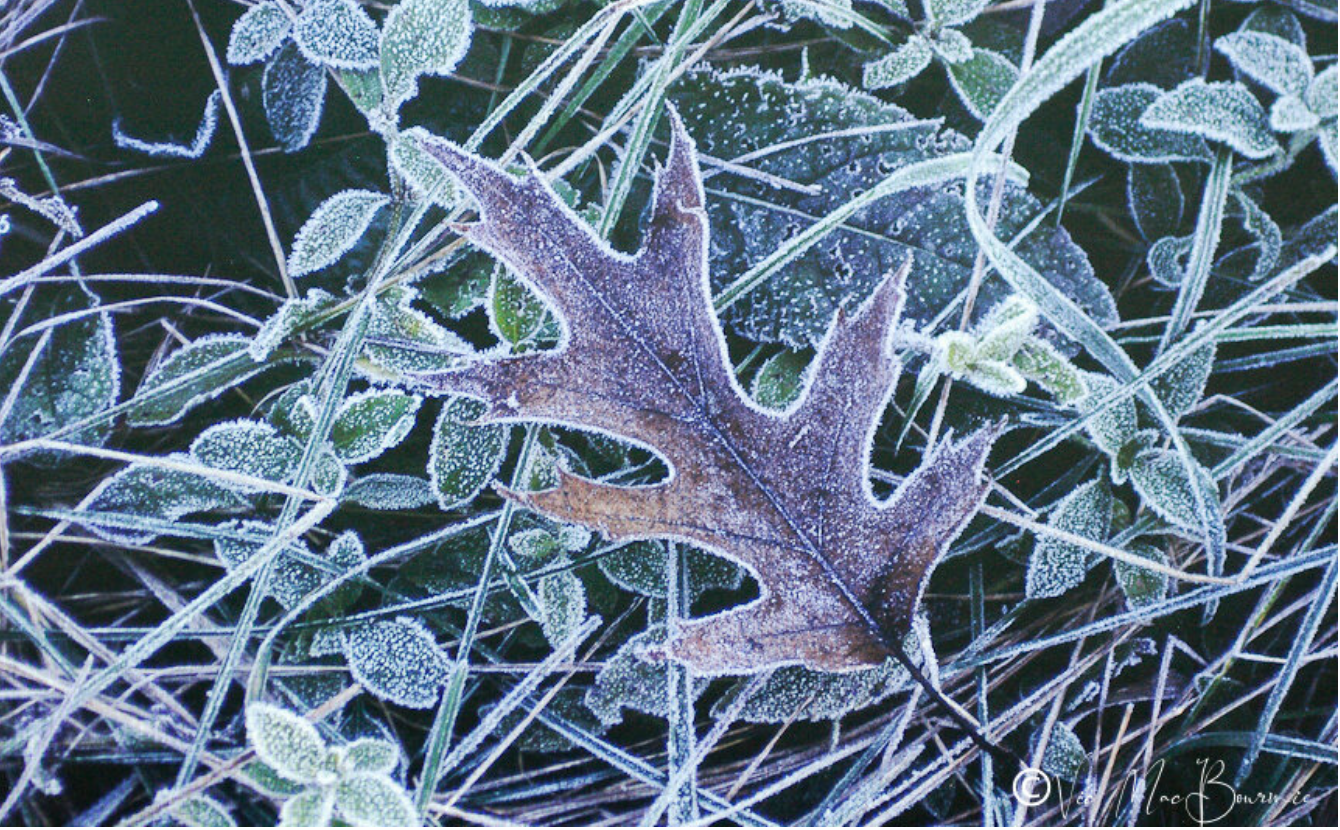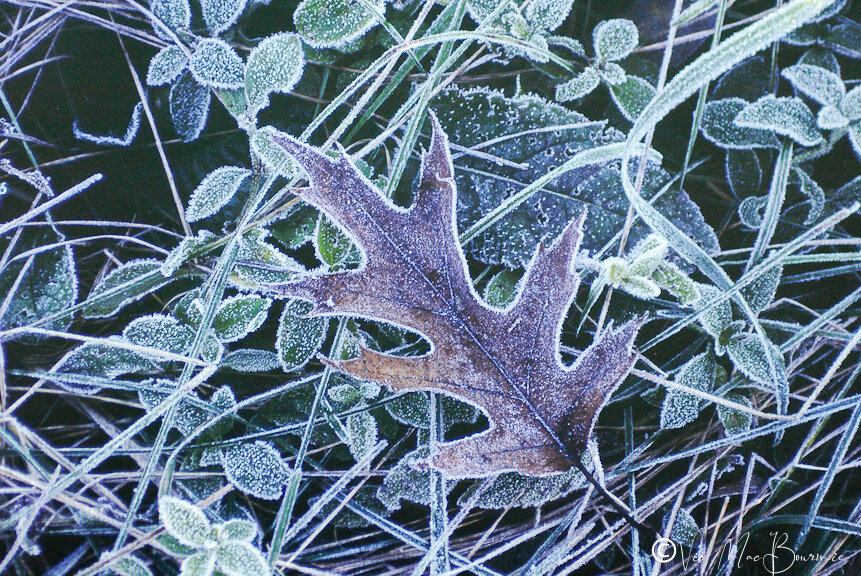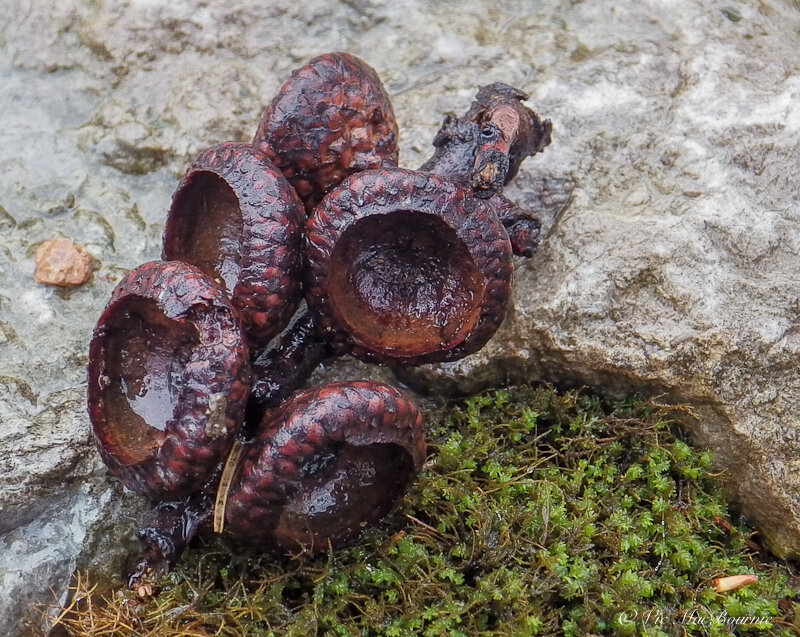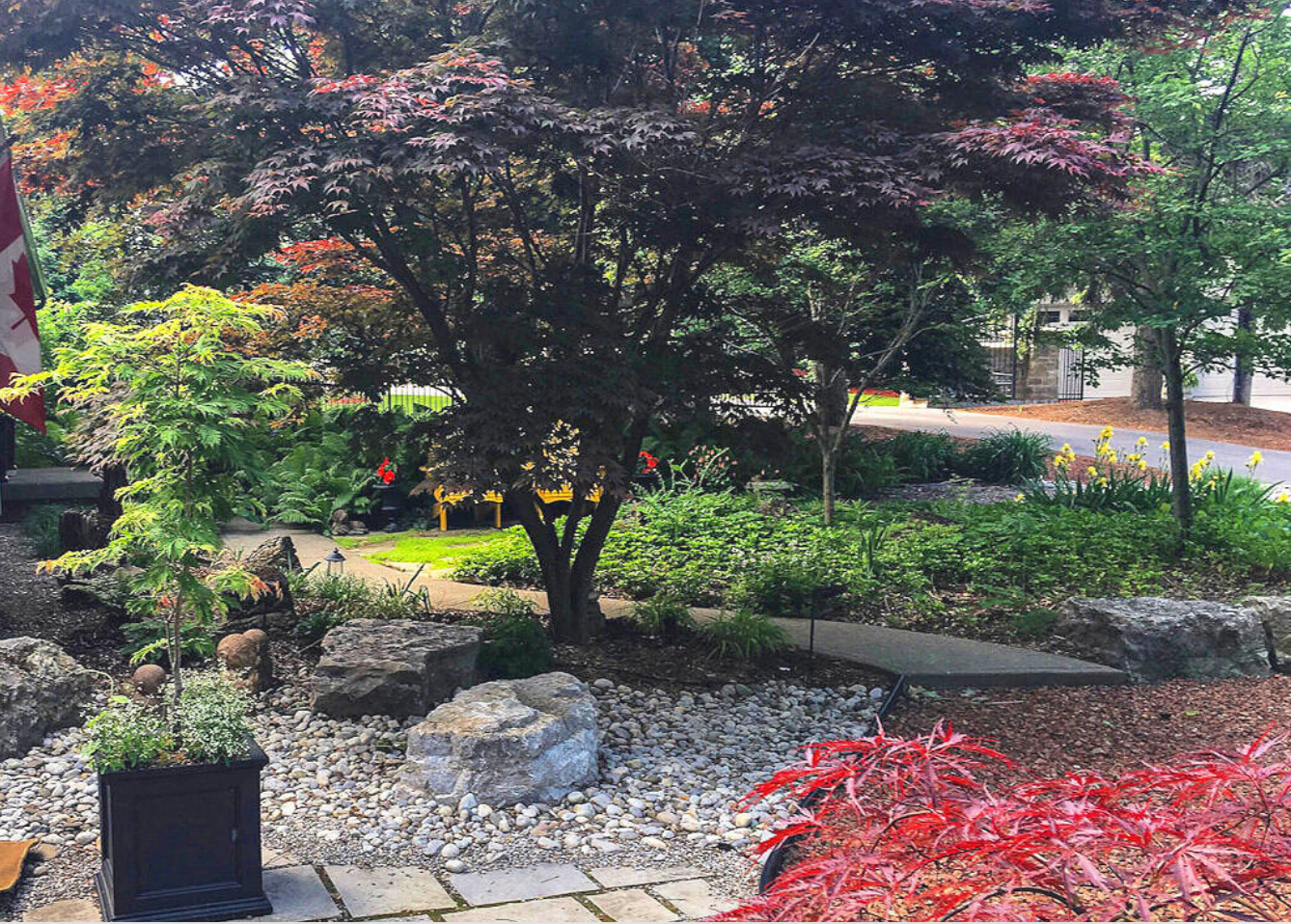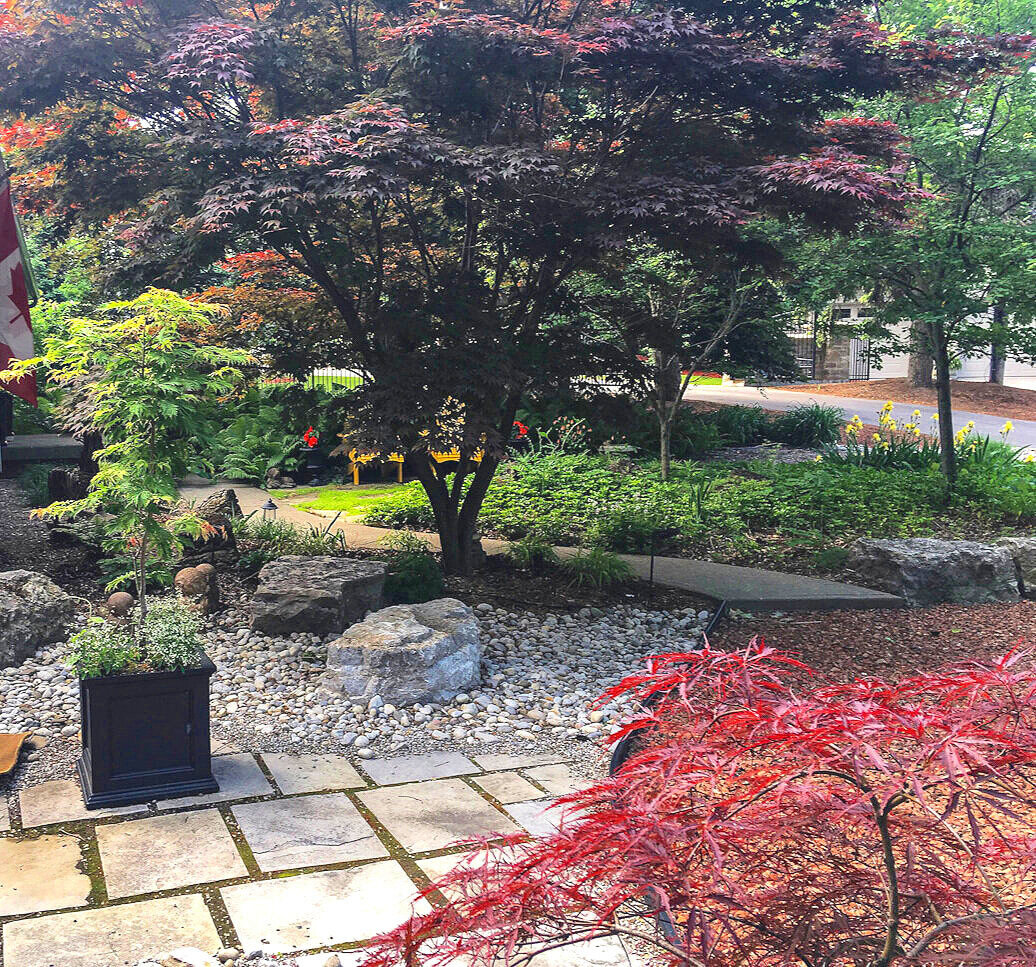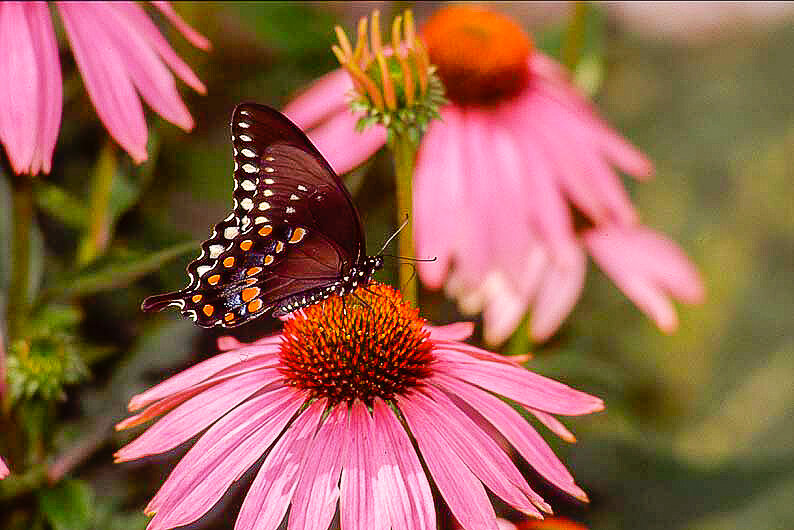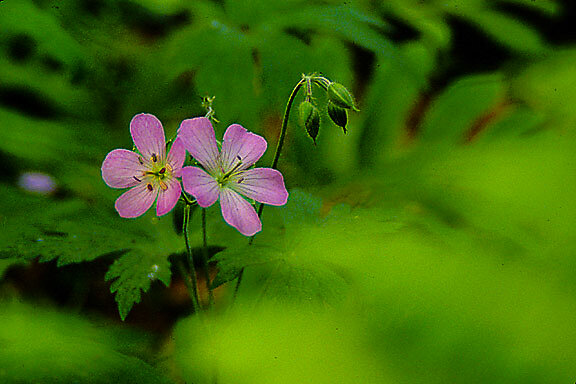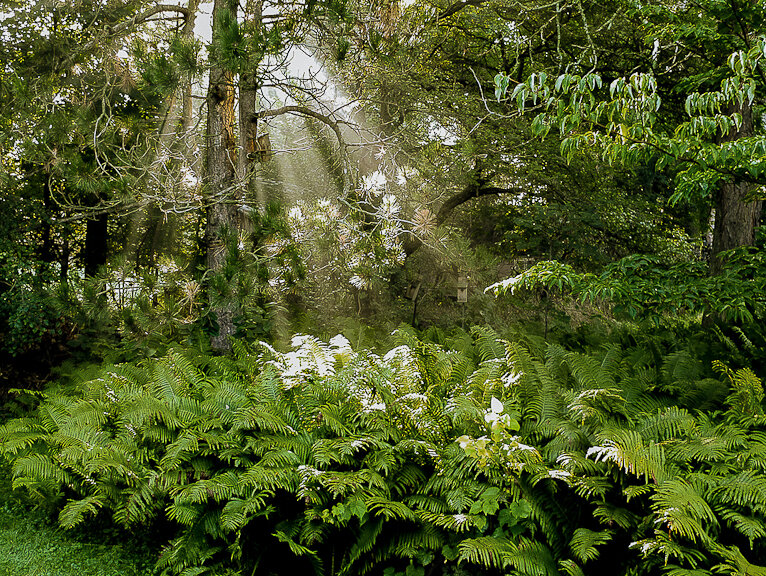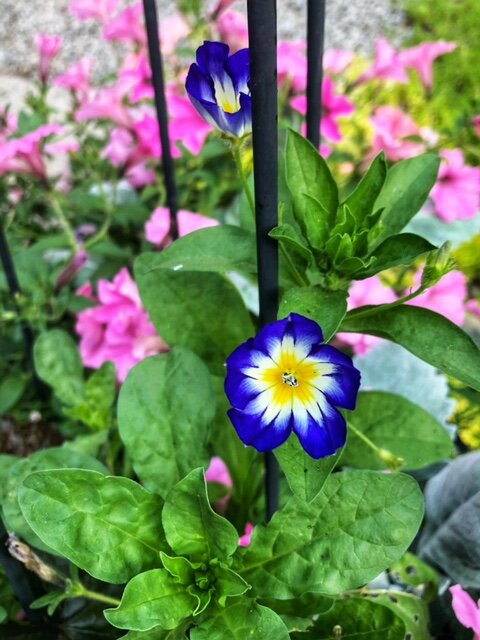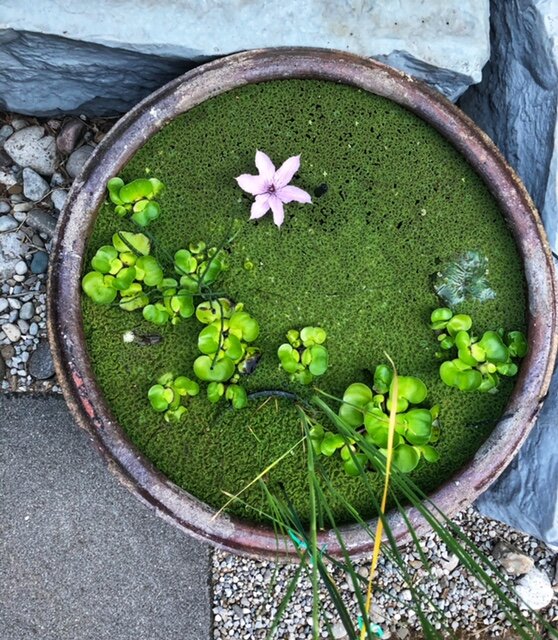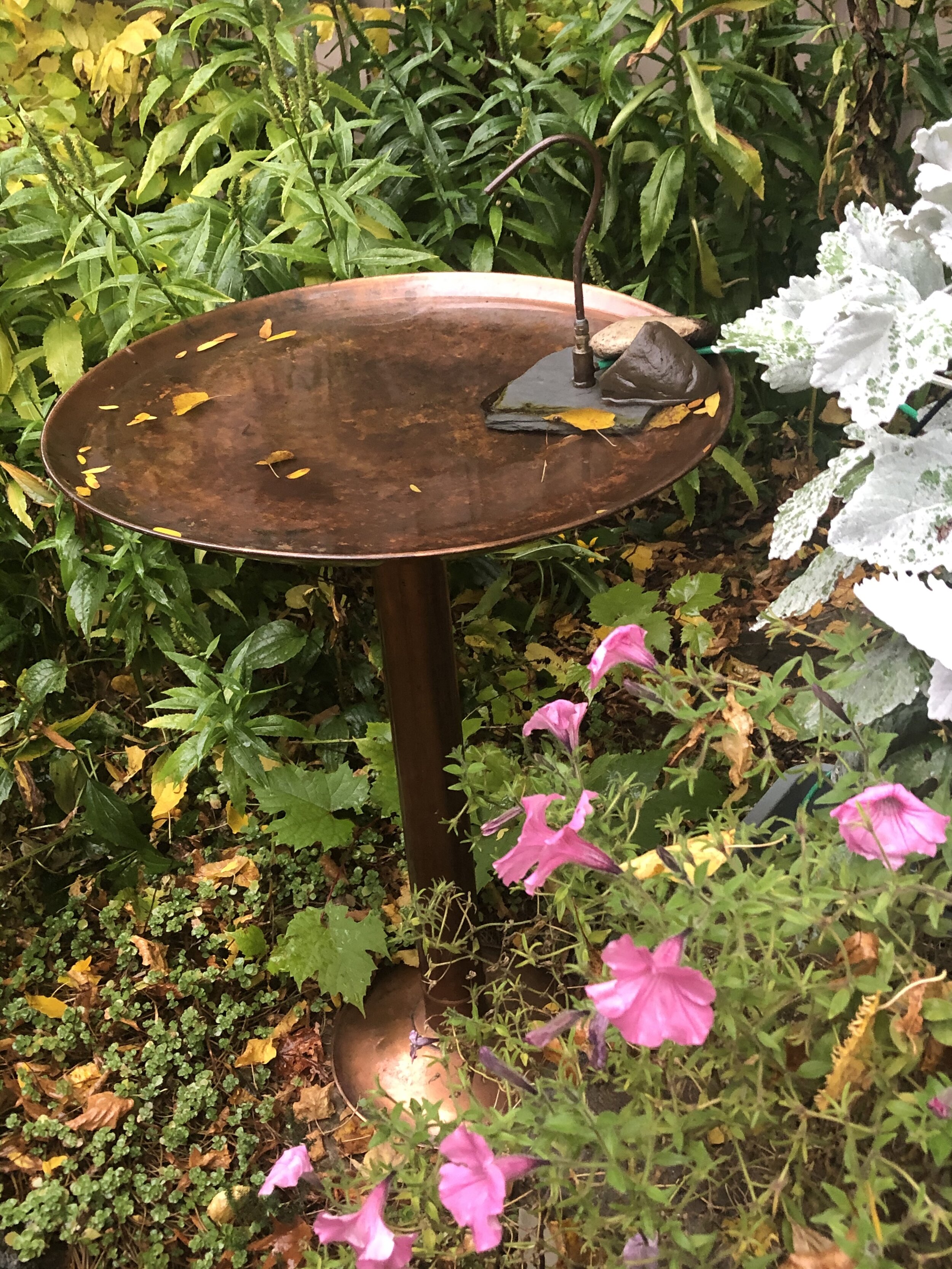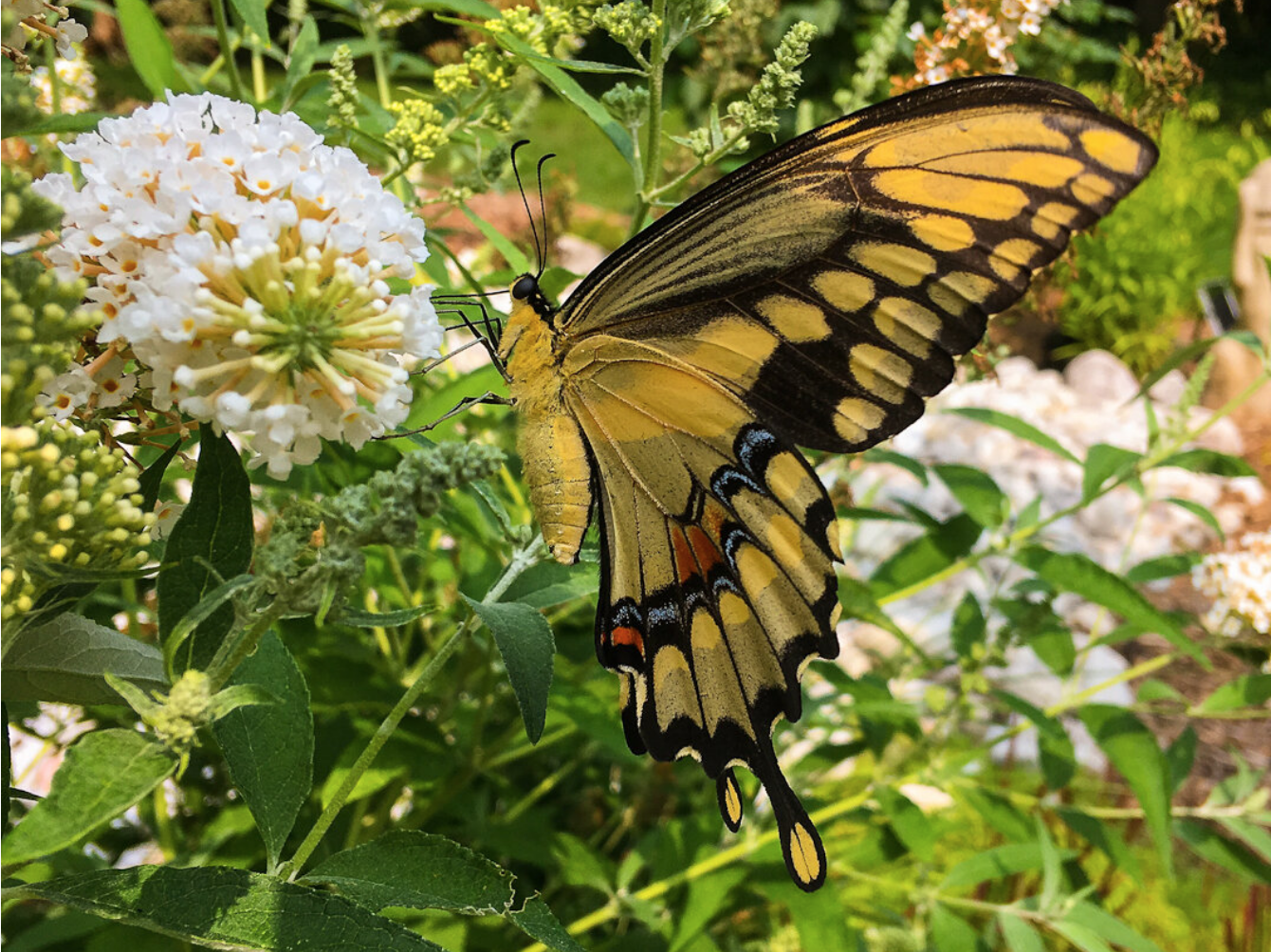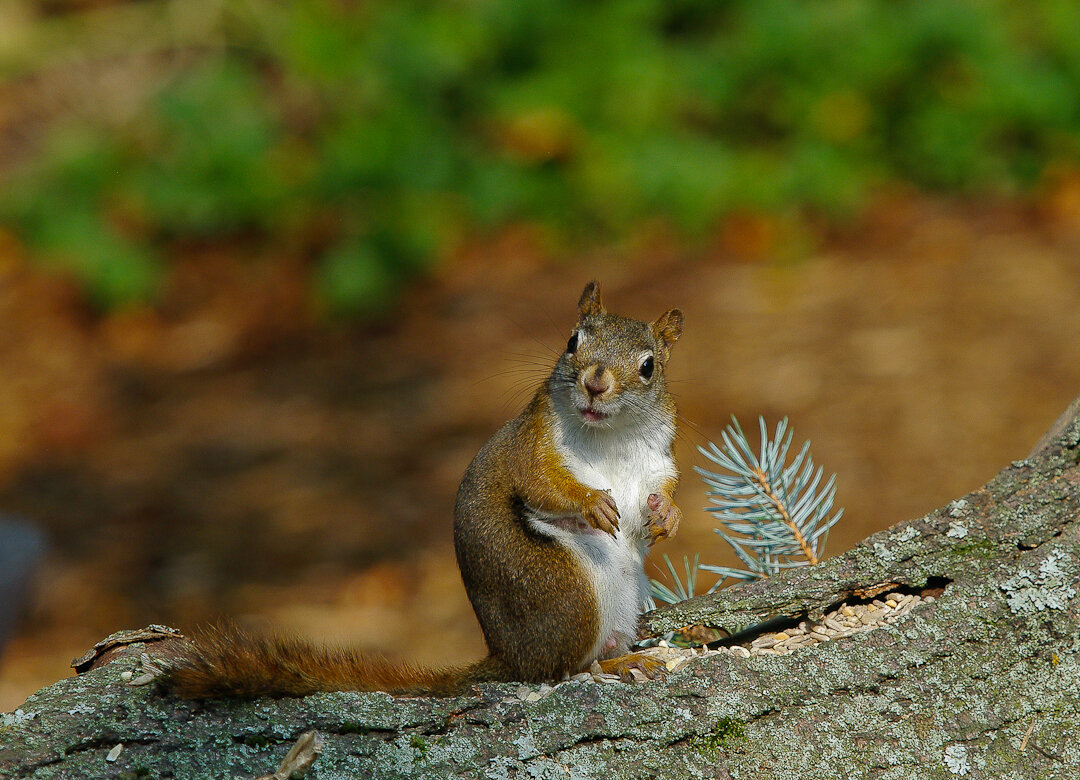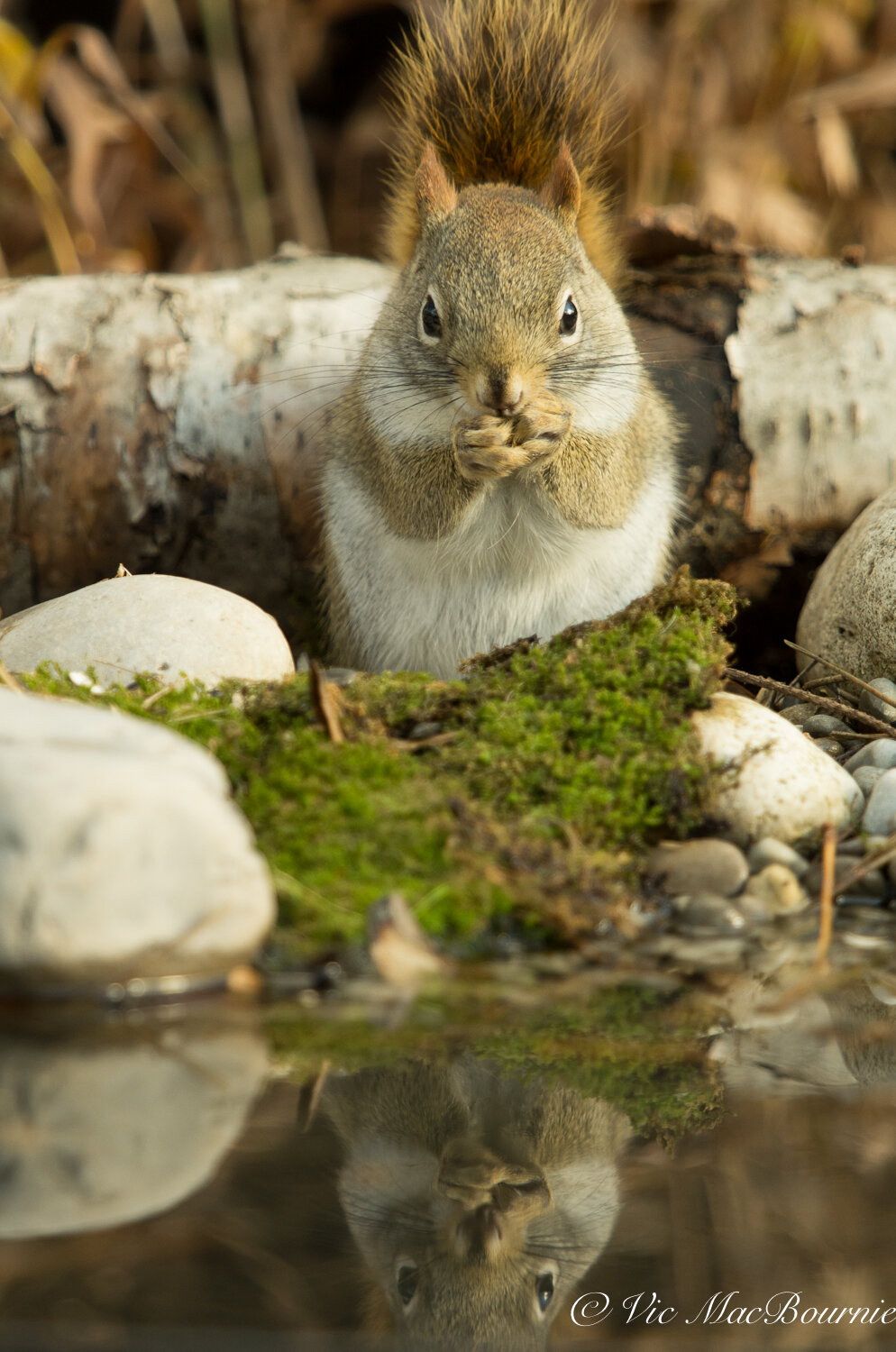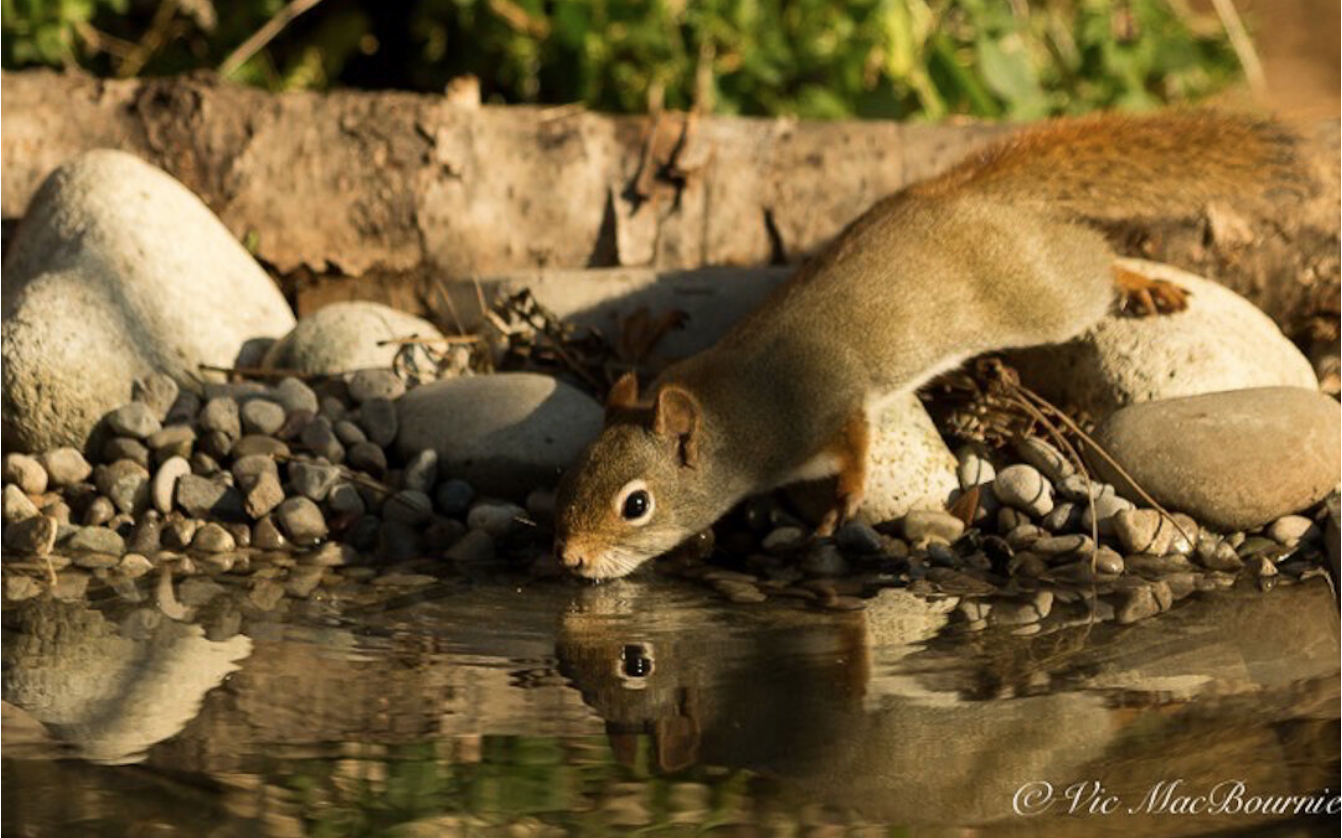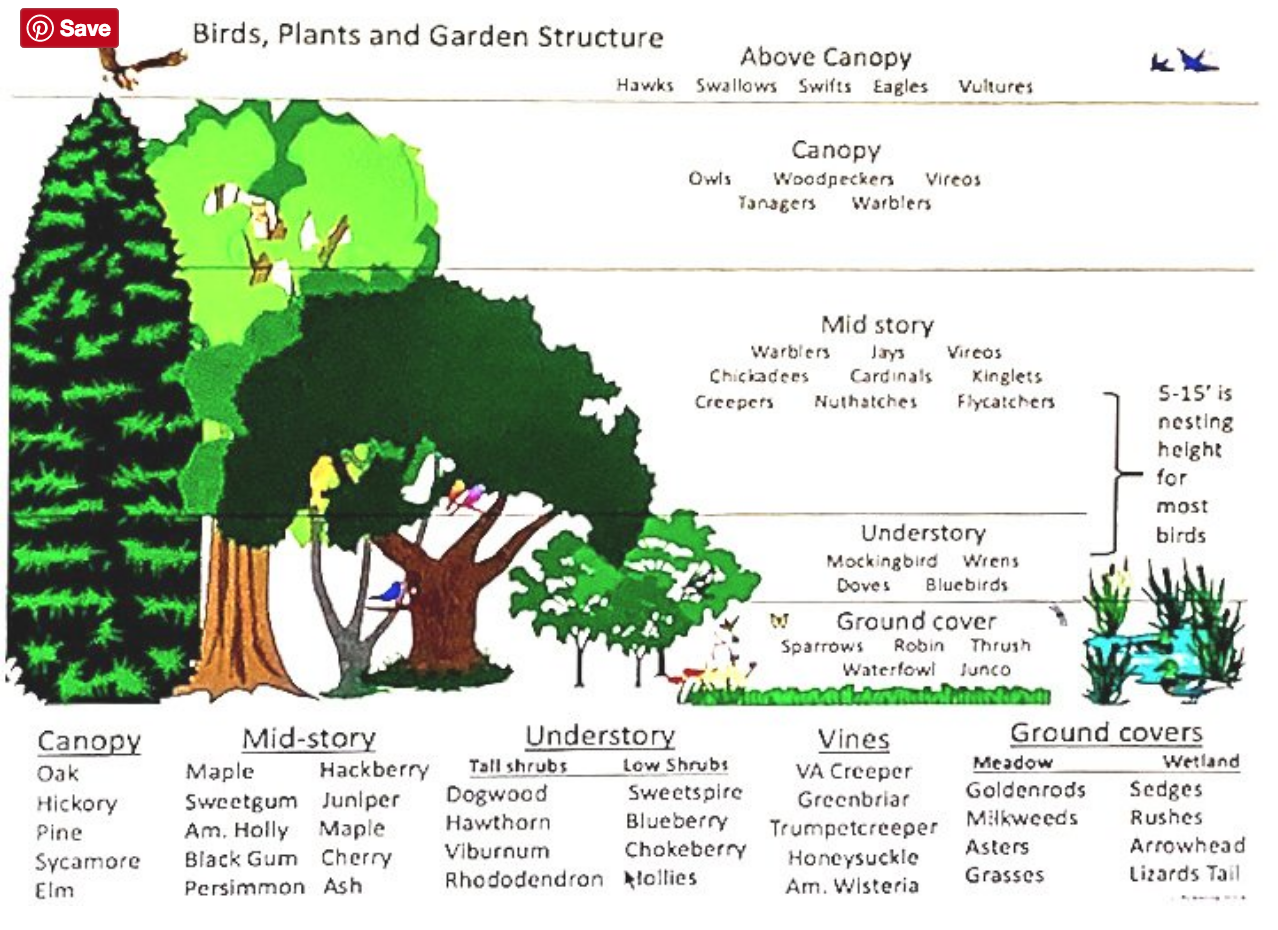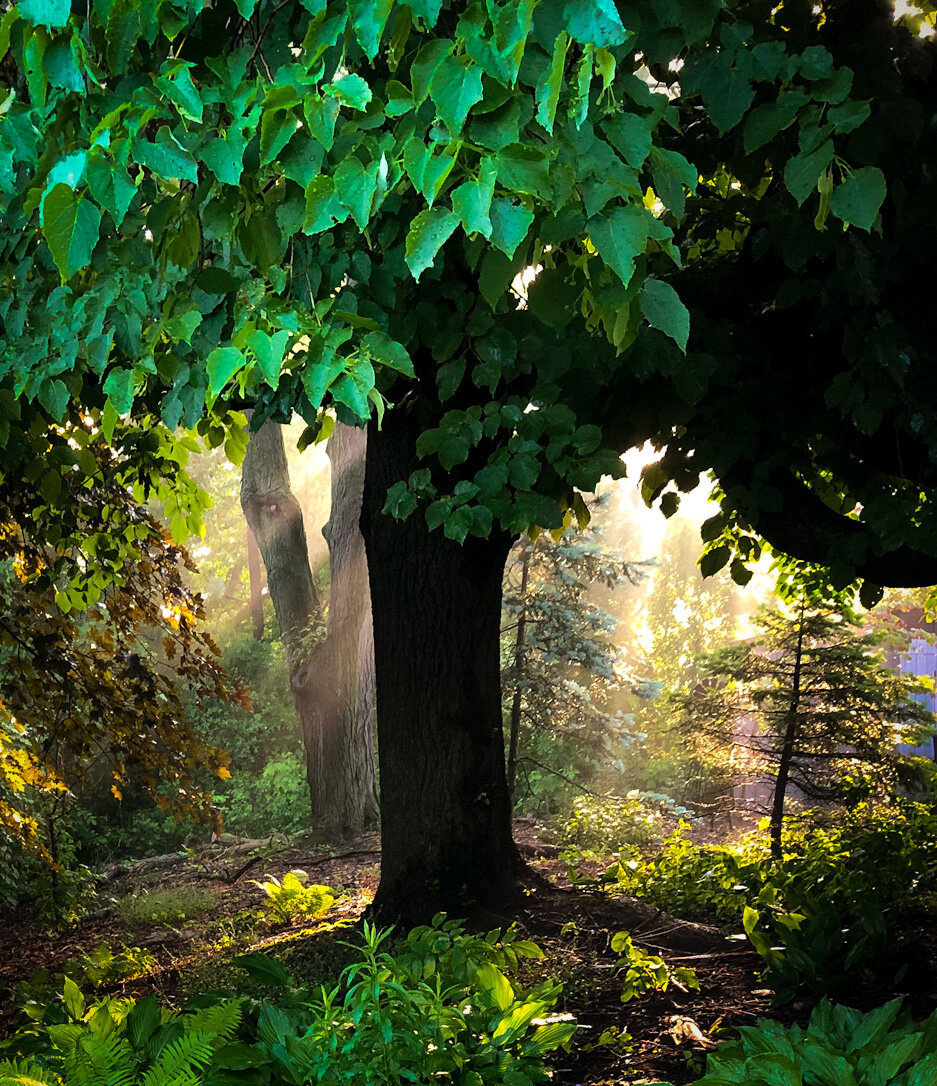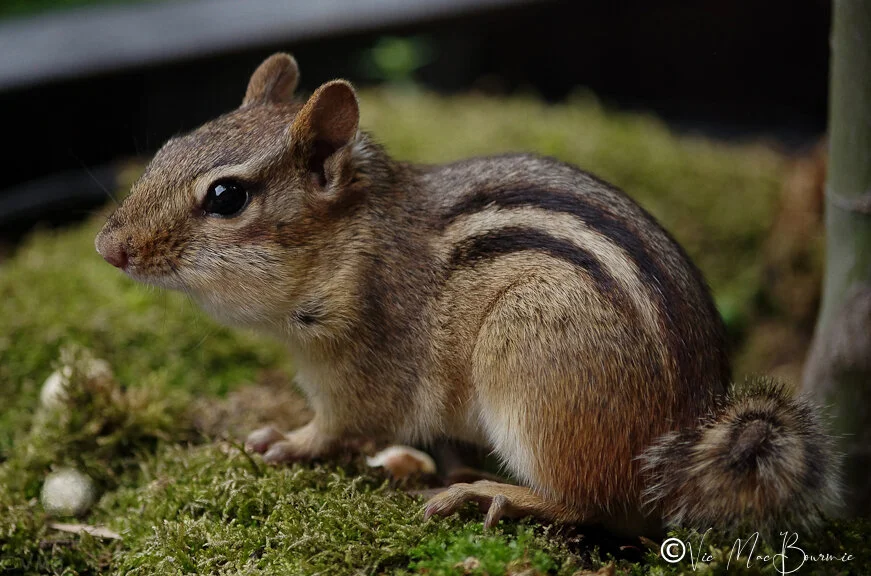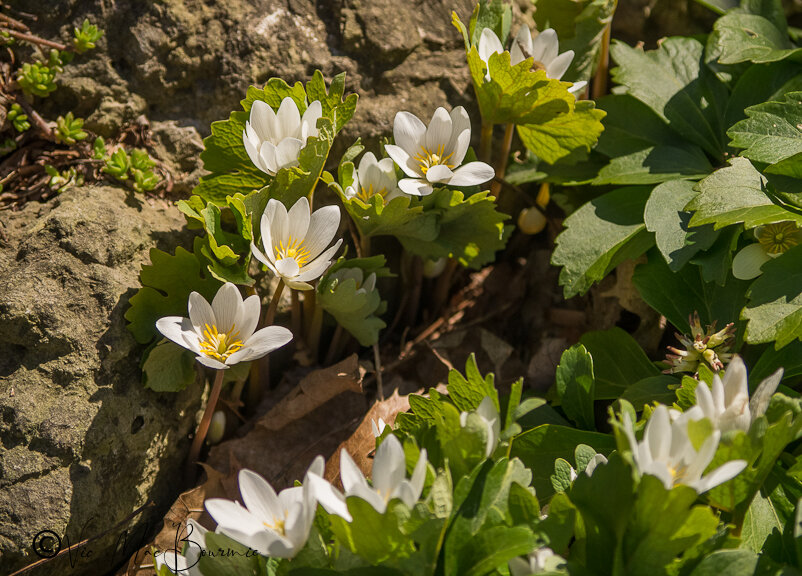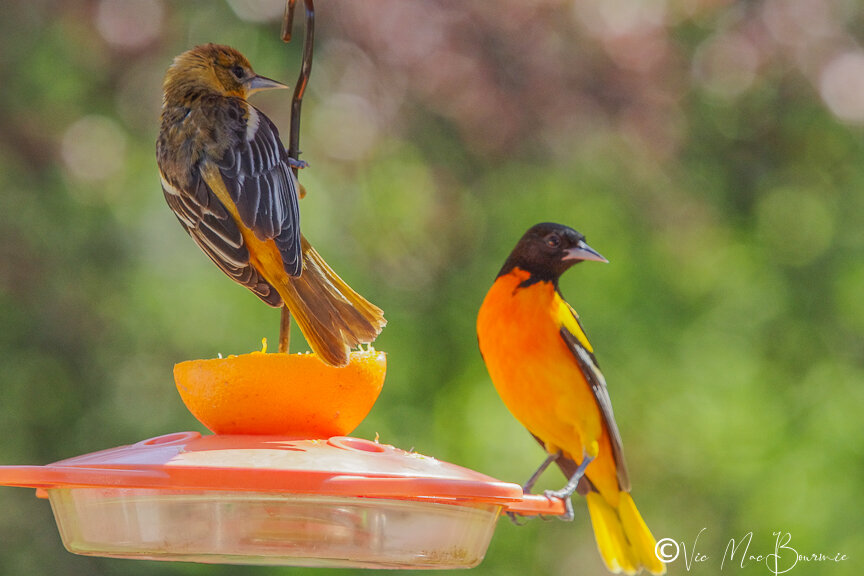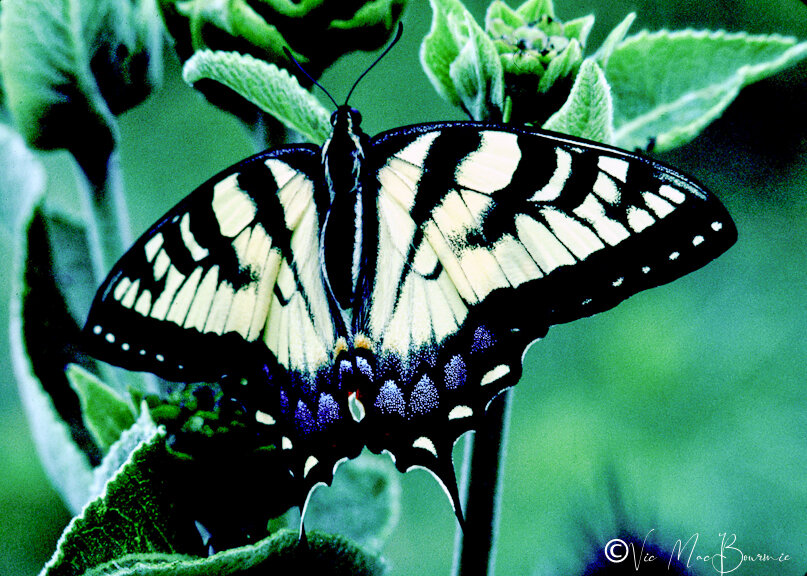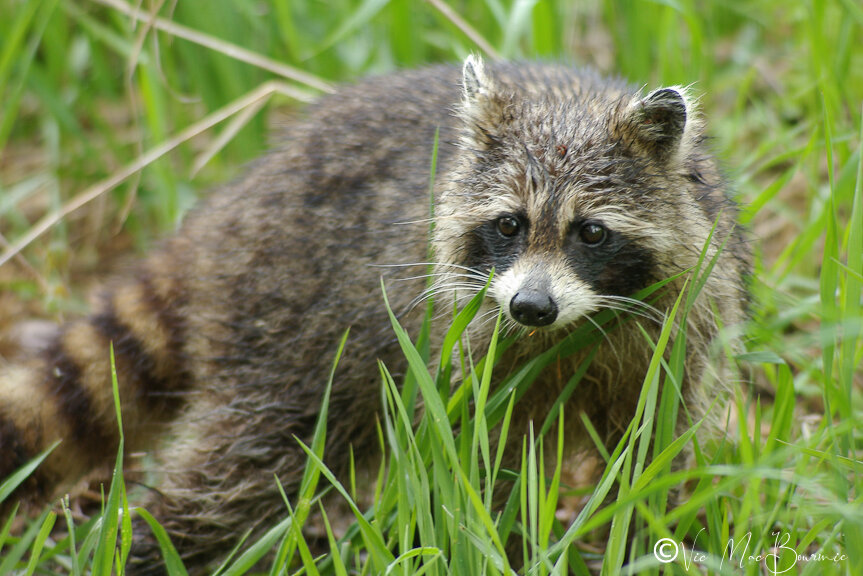What tree should I plant in my backyard?
What tree should I plant in my garden? A question heard often in on-line forums and nurseries everywhere. The simple answer: Plant an oak tree. Its everything you want in a tree – solid, stately and it feeds, protects and is home to more forest creatures than any other tree you could plant. There is room in every garden design for an oak, and if you think there isn’t think again. Here are four great oaks to consider.
Four oak trees for your woodland wildlife garden
“We just bought our first house and we want to plant a tree. What’s the best tree to plant?”
It’s a question seen over and over again on gardening forums and one asked at local nurseries on a daily basis.
On Facebook gardening forums, the question is often immediately followed by a host of suggestions from well-meaning gardeners and homeowners offering up ideas ranging from tiny weeping hybrids to non-native, highly invasive trees.
Rarely does the word Oak tree show up.
Let me go on record to say that the best tree you can plant in your backyard woodland wildlife garden is an Oak. There are plenty of reasons to plant one of the 400 species of oak, but nothing is as important as one simple fact: Oaks support the most insect biodiversity of any tree in the woodland.
I remember when we moved into our current home. One of the first things I did in spring was to do an inventory of trees on the property. I was very happy to see a nice young oak tree growing happily in the back of the yard. Today it is a more mature oak that works hard for the birds and wildlife on our property.
If you are interested in exploring the world of shade gardening further, you might like my recent post on The Natural Shade garden.
An oak leaf covered in hoar frost in late fall.
Oaks are good for birds and wildlife
In his book Bringing Nature Home, Douglas Tallamy explains that a 2003 study found that a “single white oak tree can provide food and shelter for as many as 22 species of tiny leaf-tying and leaf folding caterpillars.” And that is just a tiny fraction of the fauna that depend on a single oak tree. In fact, the mighty oak supports 534 species of fauna, more than any other tree we can plant in our gardens.
It is followed by the willows, cherries and plums, in importance to fauna. All good choices when it comes to deciding what tree to plant in your garden.
If the Oak’s importance to wildlife is not enough, consider that of the 400 species of Oak, North America boasts 90 different species with 75-80 in the United States and 10 in Canada.
For more on the importance of oak trees in our garden and natural landscapes take a few moments to check out my other posts on Oak trees:
Oaks are long-lived trees
Oh, and no need to worry that the tree will die on you and leave a massive hole in the landscape, Oak trees traditionally live for hundreds of years. There’s a good chance your children will be watching the tree enter middle age long after you’re gone.
In Ontario and northeastern United States, that white oak you plant will grow more than 35 metres (that’s more than 114 feet) tall, can live for several hundred years and produce thousands of acorns every year to feed deer, squirrels (including flying, red and gray), chipmunks, wild turkeys, crows, rabbits, bears, mice, opossums, blue jays, quail, raccoons and even wood ducks just to name a few.
As Tallamy points out: “The value of oaks for supporting both vertebrate and invertebrate wildlife cannot be overstated.”
He explains that oaks along with hickories, walnuts and American beech, have stepped up to the plate following the demise of the American chestnut in supplying nut forage for various forms of fauna.
“Every oak tree started out as a couple of nuts who stood their ground.”
In addition, oaks – both living and dead – provide nesting cavities for our backyard birds ranging from chickadees, wrens, woodpeckers, owls and even bluebirds.
The tree species real genius, however, is what we alluded to earlier, and that is the astounding number of insect herbivores that oaks support in the forest ecosystem.
“From this perspective, oaks are the quinessential wildlife plants: no other plant genus supports more species of Lepidoptera, thus providing more types of bird food, than the mighty oak,” Tallamy writes.
(If you are wondering what the heck a Lepidoptera is: They represent an order of about 180,000 species in 126 families and 46 superfamilies of insects that includes butterflies and moths. It is one of the most widespread and widely recognizable insect order in the world, and your average oak is full of them.)
12 Cool facts about Oak trees
1) Not all acorns are created equally. Acorns produced by white oaks germinate just days after they fall from the trees. Acorns produced by red oak species germinate the following spring. Keep this in mind if you are trying to grow your woodland from seeds. It is estimated that only 1 in 10,000 acorns become trees.
Acorn hats after squirrels feasted on the fruit of the oak.
2) An oak tree produces about 2,000 acorns every year. These acorns contain plenty of nutrition including large amounts of protein, carbs, fats, phosphorus, potassium, calcium and niacin.
3) The root system of a mature oak tree can total hundreds of miles and its taproot grows vertically for some distance before branching out. This helps to stabilize the massive trees from wind, rain and hurricanes. Although most oak tree roots lie only 18 inches under the soil, depending on conditions, they may spread to occupy a space four to seven times the width of the tree’s massive crown. A good thing to keep in mind if you are planning any major digs or trenching in the area of your favourite oak tree.
4) Walking sticks and katydids mature on oak foliage, so if you have never seen a walking stick, plant an oak.
5) Oak trees appeared about 65 million years ago. They have a long history with records reporting back to the late Cretaceous deposits in North America and East Asia. Their survival might be attributed, in part, to the fact acorns and oak leaves contain tannic acid which helps protect them from deadly fungi and destructive insects
6) Some oak trees are not considered old until they hit the ripe age of 700 years. In fact, they can keep going until they hit 1,000 when growth begins slowing down. On average, however, a typical oak tree lives to be about 200 years of age.
7) During their long lives, an oak tree can produce 10 million acorns.
8) The largest living oak is said to be located in Mandeville, Louisiana. Its also considered one of the oldest clocking in at an estimated 1,500 years old
9) There are more than a few famous oaks in history beginning with the Emancipation Oak on the campus of Hampton University in Virginia which is designated one of the 10 Great trees of the world. The sprawling oak is 98 feet in diameter. In the 1860s, Mary Smith Peake broke the law when she taught African American adults and children how to read under the oaks’ branches.
10) The oak is the national tree of the United States.
11) Oak trees may be known by many in Canada and the U.S. as deciduous trees but, in fact, they can also be evergreen in warmer climates with mild winters.
12) Red Oaks are tough trees and can grow in hardiness zones from 2a through to 8b.
The perfect tree?
Sounds perfect, right? Hold on, there’s even more.
In your lifetime, the tree you plant will actually grow into an outstanding specimen that will have a dramatic impact on your landscape design. It will help to form the upper canopy of your woodland garden and you won’t have to wait until your golden years before you begin appreciating its presence in your landscape.
Its sheer size will help to block out the annoying neighbours and the rustle of its leaves will help to drown out the noise of the neighbourhood.
Too big for your yard?
‘The oaks are a large tree,’ you say. ‘Too big for my typical suburban yard.’
I say go big or go home.
Oaks are not “fast-growing” trees, but because of their eventual size they grow at a good pace. I’m guessing a pin oak planted in your late 20s or early 40s won’t outgrow most yards in your lifetime or the home’s second owners, if ever.
They grow big and strong and their roots run deep enough to give them good stability as they age. All these traits mean that you will not have to wait 40 years for the tree in your backyard to make a real difference in your landscape.
There’s plenty of time to plant smaller, understory trees for your woodland.
Today, we are going big and beautiful. Don’t think about how large the tree will eventually become 50-75-100 years down the road, think 10-20-30 years instead. Most oaks make beautiful specimen trees, but if you have room to plant a few, they make a wonderful canopy cover for woodland gardens.
But, let’s face it, not everyone wants or has room for a mighty oak in their yards, especially in many of today’s smaller urban yards.
I get it. The tree you eventually decide to plant in your yard is a major decision that you will have to live with it for a long time.
Let’s zero in on those Oaks you might want to consider for your yard.
Most oaks fall into two groups: those that derive from the white oak group and those from the red oak.
It’s no surprise that all will do well in rich well-drained soil. That’s the dream world where most of us gardeners don’t live. So, if you have an area in the garden with moist soils, consider planting a pin oak and swamp white oaks. Got dry thin soils? Look to chestnut oaks, white oaks and scarlet oaks.
A local, highly reputable nursery in my area lists 13 oak trees for sale on its web site. The following is just an example of four types of Oaks (with links to the nursery website) that are available to homeowners. Check out a full listings of offerings here.
Four oak trees for the woodland wildlife garden
The White Oak (Quercus alba) is there in all its stately presence. Listed as a “massive and stately shade tree growing 90 feet tall and 70 feet wide with an artistic, wide-spreading habit of growth and good fall colour.” It’s recommended “only for the largest of landscapes” and described as “extremely tough” but slow growing. Its fall colour is an outstanding purple, its canopy is dense with a more or less rounded form.
The Pin Oak (Quercus Palustris) is certainly a better choice for a typical front or backyard growing to 60 feet tall with a spread of 40 feet. It’s a more popular tree in our neighbourhood with its refined pyramidal shape, excellent fall colour and growth that cannot be described as “fast” by today’s standards but nevertheless fast for an oak tree. Often referred to as the swamp Oak, the tree’s dark green leaves in summer provide outstanding red fall foliage. The tree requires loose, acidic soil to perform its best.
The Crimson Spire Oak (quercus ‘Crimson Spire’) is one of several cultivars that offer many of the benefits of the Oak but in a more compact form with an eventual height of 50 feet and a spread of a mere 15 feet. The narrow columnar growth habit and deep red fall colour is ideal for screening out undesireable views while helping out local fauna. The tree’s canopy is very low (typically only three feet from the ground) meaning it does not work as an upper canopy tree in a woodland garden, but its usefulness as a screen and its compact size makes it an important consideration for anyone looking to enhance their garden’s attraction to wildlife. It enjoys full sunlight, is adaptable to both dry and moist locations and, unlike the Pin Oak, is happy in any soil type or pH level. It will do well in an urban environment and is said to even thrive in inner city city environments.
The Bur Oak (Quercus macrcarpa) is the hardiest of the oaks with a height and spread of about 80 feet and a hardiness zone going down to as low as zone 2b. This stately slow grower, with a more rounded form is best for large landscapes. Its tall canopy, ideal for a large woodland landscape design, has dark green foliage and sports glossy lobed leaves that turn coppery-bronze in fall. It’s a slow grower that needs full sun but can live more than 300 years. It will grow in most soils and is considered drought-tolerant once established.
Eastern Mixed Forests: A home for the oaks
Using nature as a guide to draw inspiration for our own landscapes, we need only look at the Eastern Mixed Forests to understand where the mighty oaks are most at home. This region, which includes the forested areas from the Atlantic Coast westward to the Prairie and north to the Great Lakes region, includes several distinct forest types, including the Carolinian forest zone, each characterized by a diffrent group of tree species. The Eastern Mixed forest region occurs east of the Appalachian Mountain ranges and include trees such as the tulip poplar, white and red oaks, American beech and flowering dogwood.
Oak woodlands in the southwest
In the semi-arid regions in the west and southwest, for example, Oak woodlands can be one of the dominant plant communites. The woodlands form transitions zones between the coniferours forests of the higher, more moist areas and the drier grasslands or deserts. They differ from other forests because of their drought-tolerant species such as the oaks, pines, and junipers that dominate the woodlands. Oaks cover the foothills of southern California and the lower mountains of Arizona and New Mexico, while pines and junipers dominate in the areas around the Great Basin, lower rockies and parts of southwestern Texas. These areas experience hot, dry summers and cool, moist winters. Fires are important to maintaining and restoring these oak woodlands.
The final decision
Back to that original question of what tree to plant in your yard. Trying to decide what tree that should be is never easy. If you decide to purchase a large tree, that requires special delivery and planting, it can also be an expensive decision.
For budgetary reason, I always suggest to keep the tree small enough to carry home and plant on your own, but there are situations when a large tree is necessary.
The first thought of many new homeowners is that they don’t want to plant a tree that will eventually outgrow their backyard, yet they love going to a friend’s or relative’s homes where a single large tree forms the backbone of the entire yard. A swing hangs from one of the branches, a couple of chairs under the canopy provide the perfect relief from the hot sun.
Maybe you grew up with a favourite climbing tree that provided hours of enjoyment every summer for you and your friends.
The move these days is to plant small trees with fancy hybridized names and sterile flowers that provide no benefit to wildlife of any kind. I’ll grant you some are cute and have a place in patio containers or near your front entrance, but it’s always a good idea to step out of your comfort zone and go big.
Interior designers beg homeowners not to settle for small furnishings and art work just because they live in a condo or small apartment. There are times to think big.
And, I believe that every yard needs one large tree if possible. And, there is no better choice than the mighty oak.
The birds will thank you. The squirrels, chipmunks, deer and rabbits will reward you. And the earth will give back to you one hundred times over.
Now go plant an oak tree.
Important links for Woodland/Wildlife gardeners
The following is a comprehensive list of links to other articles posted on this website.
• Creating a Woodland/Wildlife garden: How small can a woodland garden be. Link
• Creating a Woodland/Wildlife garden: A complete design plan and planting guide. Link
• Chelsea Award winning garden designer Mary Reynolds. See my earlier post about her book here. Go to Mary’s popular website here where she promotes land stewards to create natural Arks to help protect and restore our natural environments.
• Earlier post on Garden mulch: organic vs non-organic. Link here to my earlier post.
• Earlier post to my favourite ground covers for the woodland garden. Link here to my earlier post
• Earlier post on using a local woodland as inspiration for the woodland garden design. Link here to my earlier post.
As an affiliate marketer with Amazon or other marketing companies, I earn money from qualifying purchases.
Building your garden on a Budget: Invest in these money-saving tips
Creating a garden of your dreams can be expensive, especially if you’re young with children and in your first home. The good news is that you have time to create that woodland, cottage or contemporary garden on a budget you can afford. The keys to a successful landscape plan are patience, the willingness to get your hands dirty and learning the money-saving tips to get you on the right path.
Gardens can be your best investment
I can’t think of a better place to invest time and money than our gardens. Not only do they give us great joy, they keep us healthy, get us out in nature to experience the birds and wildlife and, if done right, increase the value of our homes astronomically.
It’s an investment you just can’t say ‘no’ to.
How do we garden on a budget? First, ensure you are getting a great return on your investment by creating your dream garden on a tight budget always purchasing young trees at great prices, growing your own plants from seeds and dividing theses plants to create even more. Building a budget friendly garden is like investing: Buy cheap and let time build your investment.
This large Japanese Maple in my Japanese-inspired garden was the first tree I purchased when we moved into our home more than 20 years ago. If I remember it was on sale for less than $50. Time has made it a priceless addition to our garden.
20 tips to save money in the garden
Create your garden/landscape on a budget by following these 20 tips.
Buy trees when they are young and inexpensive. Let time increase their value.
Grow perennials and annuals from seed.
After about three years divide your perennials for lot s of free plants
Remove or reduce grass to cut long-term future watering and maintenance costs
Ask relatives, friends and neighbours for divisions of their perennials
Purchase gardening tools such as shovels, wheelbarrows etc used at garage sales, estate sales and sites like Kijiji.
Share the cost of rarely used garden tools with your neighbours. Share a snowblower, High-pressure cleaner, even an lawn mower.
Use weekends to tackle landscaping projects on your own rather than hiring professionals
Look to thrift stores for garden containers, tools, hoses and other garden products
Rent expensive equipment you don’t use often rather than purchase them.
Learn to reuse items in your home and garden as garden art, containers
Consider using solar lights to save on electricity costs
Start a compost heap to save money on soil
Practise xeriscaping to conserve as much water as possible on your property
Ask local tree services for truck loads of free bark mulch
Consider growing your own fruits and vegetables to save grocery bills
Practise low maintenance gardening with native plants that don’t require the same care and costs as many hybrid shrubs, plants and trees
Use large trees to throw shade on your house to reduce expensive air conditioning costs
Take the time to learn garden landscape and maintenance skills such as proper pruning techniques and basic deck or patio construction to save money.
Consider hiring students in the summer to help you tackle major landscaping projects.
For more money-saving tips for your garden, check out my separate post Ten money-saving tips for the weekend gardener.
Most of us are aware that properly landscaped homes can add tens of thousands of dollars to the value of our properties. Real estate agents will tell you that landscaping not only adds value immediately, it actually increases yearly as the landscape matures.
Interior decorating goes in and out of style and eventually is more of a negative than a positive on the value of your home. Landscaping, on the other hand, ages and matures creating both beauty and value that only large trees can offer and only time can create.
Just compare a typical new subdivision with an older, more mature one and it should be obvious how important a well landscaped property and street can transform a neighbourhood.
An article in the Washington Post states that a quick Google search resulted in a variety of results on the return on investment of landscaping. It found numbers ranging from a 100 per cent to about 1,000 per cent return on investment as a result of adding landscaping. With the price of today’s homes, that adds up.
So it’s clear, landscaping is valuable. It can also be expensive. But it doesn’t have to be.
(Curb appeal can pay off big. Check out my article on adding curb appeal to your garden on a budget.)
If we could only come up with a plan to landscape our homes on a budget.
The choices are numerous.
We could do the landscaping ourselves, pay a traditional landscaping company to do it all, or just pay a landscape designer, like Angela Den Hoed of Soil and Ink, to create a design that we (as homeowners) can create over time. The final option is an excellent compromise that allows us to create a professional landscape on a tight budget and do it over a long period of time. This not only helps to spread the cost over ten or even 20 years, it allows us to grow our gardening knowledge along with the garden.
This article, however, is not about landscaping. I want to focus on the soft material (the trees and plants) rather than hardscaping (rocks, paths, decks etc.).
It all begins with trees
What makes me an expert in creating a garden on a budget, you may ask?
Well, I’ve always been a little on the cheap side. Some would call it thrifty, but let’s face it, cheap is a better description. At least in my case.
Of course, a lot of my “cheapness” comes out of necessity. Being a journalist for your entire career is no way to get rich. However, I’ve always believed that if you don’t have a lot, make the best of what you’ve got.
With that in mind I can honestly say that some of the best investments I’ve ever made are in my garden.
For anyone interested in establishing a woodland garden, the most important savings begins with the installation of trees. Depending on the size of your garden, you are likely going to need several trees. Big trees like Maples and Oaks for the upper storey, and smaller ones like serviceberries, Dogwoods and Redbuds for the under storey.
My wife and I were blessed with several large trees on our property when we moved in, including a large Linden, two locusts a pine tree and two maples in the front yard. Because the neighbourhood is mature, we were also able to benefit from a shared landscape, using our neighbours’ trees as part of our overall landscape. This is certainly a huge bonus, if you are lucky enough to benefit from others’ smart landscape choices and one that helps keep your costs in check.
This left us with the task of primarily adding under storey trees as well as larger trees, if a good deal happened to come along.
Trees can be expensive and each year you wait you pay more, get less and, most importantly, lose precious time.
So the Number One tip to budget-friendly gardening is to plant your trees small, but plant them early.
In fact, if you are moving into a new home, make it the first thing you do. Plant at least some of your trees. If you buy them on the small size, they are easy to plant and they will root in more quickly than a larger more mature tree would.
Trees that I purchased years ago and slipped into the back of my old Subaru station wagon are now mature specimens that would be difficult to get on most flatbeds let alone in the back hatch of a car.
My neighbour and I recently planted a cedar hedge between our properties. Several cedars were about 10-footers but the nursery ran out so we had to plants some three foot versions. We planted them in an area that gets more light than the others and in just one year they put on about twice the growth of the larger cedars. By the end of the second year, I expect that most people will be hard pressed to see the difference between the larger cedars and the small ones.
Building a garden on a budget does not have to be difficult. Flowers, for example, can be grown from seed, increased by division, or allowed to reseed themselves and naturalize in our gardens. All for free. The following list are just a few flowers that are almost free for the taking.
Black Swallowtail and purple cone flower.
Flowers easily grown from seeds
• Columbine (aguilegia) – An early summer bloomer known to attract hummingbirds and other pollinators to your garden. It’s a perfect woodland addition but can work in a more meadow environment as well. It will self seed if happy, but feel free to collect the pods after flowering, shake out the seed and spread them into different areas of the garden.
• Yarrow (Achillea) is a hardy, dependable plant with clusters of flowers available in a variety of colours and is a perfect landing spot for butterflys. It can spread quickly and has a long blooming season. The spent flat-topped flowers even look great throughout the winter.
• Allium (Onion family) these rather unique purple round-headed flowers are a very architectural addition to a garden rising up through other vegetation.
• Sweet William or Dianthus is is a biennial or short-lived perennial prized for its small flowers that bloom from late spring to the first frosts of fall. It can grow in hardiness zones from 3-9 and the sweet smelling flower that grows performs well. Sweet William will reseed each year in optimum growing conditions.
• Coneflower (Echinacea) is a favourite of most gardeners with its large, sturdy, long-lasting blooms. A favourite of both pollinators and many birds that depend on the seeds as a food source in the fall and throughout the winter. The birds will help to spread the seed, but capturing it on some of the spent flowers and distributing it in the garden is an excellent way to multiply your plants with little to no work.
• Gallardia (Blanket flower) is a butterfly magnet with its daisy like yellow, orange, or red flowers creating an enticing landing pad for them.
• Shasta daisy add a joyful feel to your garden with their bright white flowers and lemon yellow centers. Easily grown from seed or division.
• Lupine (Lupinus) is a longtime favourite in gardens. The tall and showy spikes of the lupine comes in purple, pink, yellow, red and white but look for the native lupine which is smaller and blue in colour and the host plant for our threatened Karner blue butterfly.
•Penstemon (beardtonque) Stalks of tubular flowers (pollinators and hummingbirds) that begin blooming in early summer.
• Black-eyed Susan (Rudbeckia hirta) is a popular tough-flowered perennial that performs from late summer into first frost and is a great late winter food source for birds. If given time, these plants will spread on their own and create lovely drifts but you can help them along by gathering some of the seeds and distributing in various locations that are crying out for a little late-summer colour.
Wild geranium and ferns. Not only is it a stunning plant, it spreads beautifully providing free plants and creating a lovely ground cover that is attractive to bees and other pollinators.
Let patience work for you
When it comes to gardening. saving money is really about patience.
• Patience to plant a seedling or a young whip and watch it grow into a beautiful tree.
• Patience to tackle as many garden landscape projects as possible on your own.
• Patience to wait for the garden to mature over time.
• Patience to buy one plant rather than five knowing that, in three years, you are going to split into a grouping of three or maybe even five.
• Patience to spend time on used sites such as Kijiji to score garden items at a fraction of the price you would if you had bought them as new items.
• Patience to grow some of your favourite plants from seed.
• Patience to wait until fall to pick up that expensive Japanese Maple on sale at 50-60 per cent off.
• Patience to let nature do its job, while you continue to work toward the garden of your dreams.
Let’s face it, patience is definitely a virtue when it comes to gardening.
And, one of the great benefits of gardening is that if you start young, and have patience, both your knowledge and savings grow exponentially.
I remember shortly after moving to our current home, say some 20 plus years ago, and seeing a small notice in our daily paper from an environmental group advertising two free native trees for anyone interested providing you could pick them up. My trusty Subaru station wagon came in handy again. I arrived to see a forest of trees being offered for free. And they weren’t little whips either, they were good-sized trees.
I picked up a tulip tree (a fast growing Carolinian zone native tree), and a single-stem native serviceberry. Both are now mature specimens. The tulip tree is probably four-storeys high and the serviceberry is an outstanding addition to our front yard attracting a host of birds, chipmunks and squirrels every summer when the fruit ripens after the tree’s spectacular spring bloom of ethereal white flowers in May.
That was entirely an investment in time and a little energy planting them. But, I was young then and had lots of time and energy.
More recently, I remember buying three weeping birch tree whips for $9 each maybe 10 years ago. I have long since forgotten what they were called but they appear to be a variety of tall, slim weeping birch trees named Royal Frost with burgundy leaves on the traditional white trunks. It has taken a number of years for the trunks to turn white, but we now have three lovely, unusual birch trees that are only getting better with age. They are planted in the front of our property in a nice grouping that provides some privacy, but more importantly gives our local bird population a place to rest while they sing outside our family room windows.
These specimens, after about ten years of growth are priced in the $200 a tree category. Of course that does not include the cost of delivery and planting, since these trees are now probably too large for me to plant on my own. That $200 tree with delivery and planting is going to cost $300-$350. Multiply that number by three and you are looking at about $1,000.
That $30 investment is looking pretty good now isn’t it?
If we learn anything from these examples, it is not to wait until you have the money to create the garden of your dreams. Buy those trees now, plant them now, and be patient.
Important lesson: Don’t buy a tree simply because it’s on sale, buy it because it fits into your plan. Have a good idea of the type of trees you want and then start your search.
Places to purchase trees on a budget
• “Big box” stores have been a source of some rather interesting deals for me. I like to visit their garden centers in the spring to check out what they are carrying that year. Regular visits throughout the summer waiting for sales have paid off several times, especially with native trees that most “big box” garden shoppers are not familiar. I have scored several flowering dogwoods (Cornus Florida both red- and white-flowered varieties) and a Redbud (Forest Pansy) for 80 per cent off at the end of summer sales. The highly-valued native specimens cost me about the same as a decent-sized perennial would cost in spring.
• High-end garden nurseries are traditionally not the place to get your best deals, but pay attention in the spring and fall when sale prices can get you some less common trees that you would never see in the “big box” outlets or traditional nurseries. Spring is the time to grab last year’s stock that might not look appetizing to most spring shoppers. My favourite local garden nursery has an area in the back full of “ugly” plants and trees that will work perfectly in a woodland setting, especially at 80 per cent off. I have picked up some rare Japanese Maples for 80 per cent off as well as some beauty bushes that they were almost giving away because there were no tags on them. I happen to recognize them right away and scored them for pennies on the dollar.
• Local Garden Club fundraising sales are a must. Obviously, flowers are a bigger draw for most who attend the local sales, but I head straight to the back where the trees are usually stored. Native trees are often in the pack because shoots from their fruit can sprout up from around mother trees and are a great way for the local gardeners to make a few dollars rather than put them in the compost heap. Serviceberry, Pagoda Dogwood, and Redbud are just a few of the trees you can expect to score for the cost of a couple of coffees for a smaller tree, or a couple of burgers for a good-sized specimen. A bonus to buying at the local Garden Club is that you know the tree was already growing and prospering in your neighbourhood. Don’t be scared off if the tree looks like it’s struggling. Chances are it was dug out of it’s comfortable garden home the night before and is in a little shock. Plant it quickly give it some love and it should do fine after a period of getting acquainted with its new environment.
• Kijijij and Craigs list can also be a source of trees. Believe it or not there are more trees on Kijiji than you might think. And lots of them are great deals. I picked up a white pine for $10 from a woman who was growing it in a container until it started to get too big. I picked up a Serbian Spruce that the woman decided was going to get too big for her yard and I’ve seen homeowners willing to give away beautiful Japanese Maples for anyone willing to come and dig them up and cart them away in a truck. Trees that would cost hundreds if not thousands are free for the taking with a little effort. Again, it helps to be young or, at least know some strong young folks.
• A lot of people simply steal their trees from nature. This is rarely a good idea, especially if you are travelling a great distance to obtain the trees in a different growing area. (See my article on why taking trees and plants from nature is wrong here.) Chances are, you will damage the roots to an extent that will eventually lead to the death of the tree. There are times, however, when “saving trees” that are “standing in the way of progress” can be a good idea. In cottage country, for example, if trees are being threatened to make way for a road, a cottage or resort. With permission, this can be an excellent way to gather a number of trees. Don’t be tempted to take the largest ones possible, however, the smaller ones will have a much better chance at survival.
Our fern glen started with just a few ferns donated from a friend and spread to encompass a huge area of a corner of the garden. Deer will often hide their fawns in the ferns for the day. A great example of using free plants and patience to create a stunning area in your garden.
Plants for pennies with a little planning
Let’s face it, who is paying for plants these days?
Answer: Too many of us.
We all fall in love with the latest and greatest hybrids from the major plant growers. We can’t live without the latest golden variegated hosta, or the triple petunia. That miniature shrub is so much better than the large one I have growing in the back.
I get it, there is a time when we need to treat ourselves with that special plant, but, in the meantime, we can take action to save some serious coin on the rest of our garden plants. If we make a solid effort to save on most of our plants, we can afford to splurge on a couple of favourites every year.
This small Morning Glory was raised from seed scattered into the container in early spring. Morning glory is easily raised from seed adding a colourful climber to your garden for pennies.
But do yourself a favour, focus on perrenials not annuals.
Over the long haul, you’ll save a small fortune by making perennials the stalwarts in your garden design. Use the annuals for hits of colour, in planters and hanging baskets.
Perennials can be grown from seed, shared between friends, split every three to five years to create more plants, and, if left to reseed themselves, can be multiplied by doing a whole lot of nothing. That, as financial consultants would say, are dividends working hard for you.
Penny pinching your perennials
• Grow your favourite perennials from seed you get from friends, relatives or maybe a seed or two from the plants at your favourite nursery in the fall. Most people have no problem offering you seeds from plants in their gardens.
• Divide and divide again to create more plants. Most plants need to be divided every three to five years when their centers begin to die out. Division works for most perennials including grasses, hostas, black-eyed susans, and ground covers like Sweet Woodruff, Lillies of the Valley, Pachysandra, Stonecrop, Snow in Summer and the list goes on.
• Trade your divisions with neighbours, friends and family. This works really well for ground covers and plants like hostas where you can never get too many varities.
• Let Mother Nature bring flowers to you. Look for native wildflowers that have been left behind by birds, animals or even just wind blowing seeds around. Milkweed is a perfect example of a native wildflower that readily seeds in your garden if you let it. the fact that it is the host plant for monarch butterflies should make it a prized volunteer to any garden.
• Do you have a favourite perch that birds congregate on? If not, consider stringing a clothes line across an area of the garden where there is open soil and let the birds sow the garden for you. You might be surprised with the results. You will certainly find out soon enough what they are eating in your neighbourhood and you can rest assured the plants that will emerge from the seeds will be appreciated by your feathered friends.
This patio pond container was one of several Kijijji finds at a fraction of the cost of a new one. It has performed flawlessly for years and one of my favourite additions to the garden allowing me to grow a few pond plants without having to deal with a full backyard pond.
Buying used tips that you can take to the bank
Many years ago, I decided buying used was one way I could get many of the things I dreamed of but could never afford. It wasn’t just plants, or garden related objects – it became a way of life.
My photography equipment was and still is all pretty much used. My cars have always been used. Heck, when we purchased our house it was very used, almost worn out. My wife and I even joke that we got our cats and dogs used from the local shelters.
I’m happy to take other people’s throwaways. I can’t help it if they have a fetish for the latest and greatest. I’m happy with yesterday’s latest and greatest, especially when it’s of extremely high quality, high value and meets my needs.
(Check out my best Kijiji birding finds here.)
Anyhow, in the gardening world, old is always better than new.
In fact, you can expect to pay big bucks for the fake patina on that plastic garden ornament. Or, you could just buy the old concrete one on Kijjiji for a fraction of the price and that live lichen growing on the base of the bird bath gets thrown in for free.
“I can’t think of a better place to invest time and money than our gardens. Not only do they give us great joy for years and years, they keep us healthy, get us out in nature to experience the birds and wildlife that call our gardens home, and through smart decisions, increase the value of our homes astronomically. It’s an investment you just can’t say no to.”
You would be surprised what you can find for your garden in the world of digital classified ads.
To date I’ve purchased copper bird baths from Restoration Hardware at pennies on the dollar, a rustic bird house I’m in love with, a large concrete water container that has served as our patio pond for several years, trees, garden art, bird feeders, owl houses…. the list goes on.
If you are looking for garden tools, you will find a nice selection usually from elderly couples moving into condos and apartments who have no need for lawn mowers, hoes and clippers. No need to spend three months pay on garden tools that get scratched and beat up after only a few uses.
Once again, it’s all about patience. You may not always find what you want at that moment. Make a list of some of the tools you will need and keep checking. The listings change daily, even hourly so as long as you are patient, you will likely find what you need.
Pay attention in spring and fall when gardeners are looking to do some serious cleaning. That’s when most of the best deals are available.
One last personal example.
This lovely copper bird bath was found on Kijijiji as well as the copper dripper that was turned into a solar fountain to create moving water and attract birds. Both the bird bath and the dripper were purchased for pennies on the dollar.
Several years ago I needed a few square cut blue flagstones for a project. I found a fellow in the next city over selling flats of this expensive flagstone after removing a patio from his backyard. (Don’t ask me why he would remove a blue, square cut flagstone patio in favour of a concrete pad, but one man’s poor taste is another’s gold mine.)
I could have purchased a few pieces of the flag stone from our local garden centre for a little less than I paid for an entire pick-up truck of the flagstone but I decided I could always find a use for it so I took the enire load.
I stored it nicely stacked behind our shed until last year when I used every last piece on a major landscaping remodel.
I would hate to think how much square cut blue flagstone is priced at these days. I wonder how the fella likes his concrete pad, I know I love our flagstone stepping stones through the woodland.
There is a reason the saying: A penny saved, is a penny earned continues to be as true today as it was when we were kids. Although it should now probably read: a penny saved, is ten dollars earned.
Consider installing a high-end, off-grid solar power system
If you are like me and don’t have electricity in your garden, or at least don’t have it in the far reaches of the garden, consider installing a complete off-grid solar-powered electrical system like the American-based Shop Solar Kit company.
Maybe you have a pergola in the back of the garden, or even a she-shed that you would like to have full power running a small refrigerator, sound system or full-size lamps and lighting. If you need to run pumps and lighting to a garden pond, you can do it with one of these highly capable systems that, once installed, operate at no cost to you at all.
There are complete DIY kits available for approximately $1,500 and up.
Gardening on a budget links
Ten money-saving tips for the weekend gardener
DIY Bark Butter feeder for Woodpeckers
DIY reflection pond for photography
Click & Grow is ideal for Native Plants from seed
Remove your turf and save money
Hiring students to get your garden in shape
This page contains affiliate links. If you purchase a product through one of them, I will receive a commission (at no additional cost to you) I try to only endorse products I have either used, have complete confidence in, or have experience with the manufacturer. Thank you for your support.
Creating a wildlife friendly garden (7 simple steps)
If you have the basis for a woodland garden, you are on your way to creating a wildlife garden in your backyard. The two landscape designs work in harmony but there are specific elements to focus on to create a successful wildlife garden.
Woodland garden provides groundwork for wildlife garden
If you already have the makings of a woodland garden, you also have the groundwork for a wildlife garden.
Woodland and wildlife garden design styles are similar and can work in harmony together, but there are definitely key elements to focus on to create a successful wildlife garden.
I have found that encouraging more insects, reptiles, amphibians, birds and mammals to my garden demands a more detailed focus on the shrub and flower layers of my multi-layered woodland garden.
Generally speaking, in a woodland garden the shrub layer is often as visually pleasing as it is beneficial to wildlife. In a wildlife garden, that approach is reversed and the shrub layer’s primary purpose is to provide food and habitat for a myriad of wildlife. The flower layer also requires a more wildlife-friendly approach.
So how do we get started?
Here are the seven basic principles to create a wildlife garden. (More detailed examination lower in article)
Provide food, water and shelter
Add a variety of plants
Create islands of habitat
Create layers in the garden
Use native plants
Reduce or eliminate pesticides and herbicides
Refrain from any real fall garden cleanup
An impressive example of a giant yellow swallowtail works a butterfly bush in the garden.
Gardeners who are looking to create a successful wildlife habitat need to focus on two primary garden design elements: First, putting an emphasis on providing sources of water (preferably a natural pond), and, two, a focus on creating an edge habitat of native plants that provides both food and a safe habitat for nesting. These two factors together with an already established woodland garden will go a long way to creating a successful wildlife garden.
Habitat loss makes wildlife-friendly garden more critical
The loss of habitat is the most important single factor responsible for the reduction of wildlife numbers in Canada, the United States, Great Britain and elsewhere. The burning issue is: Can we as homeowners take action to reverse this trend in our own yards. The answer, of course, is a resounding yes. Gardeners should also be encouraged to know that creating a wildlife garden can be created and maintained in less time and using less energy than is required in a traditional garden.
Many of us get great pleasure in feeding birds at our backyard feeders, but very few landscape their properties to create a habitat for birds and many other species of wildlife.
As Irish garden designer Mary Reynolds expounds in her book The Garden Awakening, the goal of every gardener is to create an island of native plants that will provide a path for wildlife to travel through our neighbourhoods. She refers to them appropriately as ‘arks’ and is busy creating a movement bringing homeowners around the world together to create arks. (see link at bottom of article)
By using ecological principles in the design of your ark, and incorporating native plant species whenever possible, the wildlife garden will take shape and begin attracting a greater variety of fauna to your garden.
I think Reynolds ark concept can be taken a step farther in a large landscape by creating islands within your ark. Rooms, if you will, that provide more specific food sources and habitat that is particularly suited to that area in your garden. A sunny clearing in the woods, for example, is an opportunity to grow a fruiting shrub and more sun-loving flowers. A wet area provides a different opportunity to create an island to encourage everything from toads and salamanders to dragonflies and other wetland insects and butterflies as well as aquatic loving native plants, everything from native iris to orchids and blueberries.
By using environmentally sound gardening methods, landscaping for wildlife is not only landscaping for the ecosystem, it is also a people-friendly design that family and friends will appreciate and enjoy for years to come.
Begin wildlife-friendly garden with a brush pile
Probably the single most effective step you could take besides eliminating herbicides and pesticides in your garden is to create a brush pile for wildlife. It is such an important resource for wildlife – everything from insects, reptiles, birds and mammals – that creating even a simple, small brush pile will go a long way to kick-start your wildlife garden.
In our garden, we actually have two on the go. One is more of an open pit compost pile that is made up of primarily cuttings from plants and shrubs that gets topped up in spring and fall with spent soil from our many containers. Several branches placed on the pile keeps it open and accessible to small mammals. Some food scraps make it to the pile but it is not a traditional compost. Almost all the soil is left in place on the pile to encourage biodiversity in the pile. I have seen Coopers hawks hunting there on a regular basis as well as fox and snakes.
The second pile is a more traditional woodpile made up of large, medium and small branches, the result of a recent tree trimming. It became the main dumping ground for small amount of fall leaves we collected this year. In a few short months, it has become a favourite spot for a family of red squirrels as well as a number of insect eating birds that patrol the pile on a daily basis for insects, eggs and pupae. For more on the importance of a woodpile, go to the bottom of this story for a link to an earlier story.
Difference between wildlife-friendly and traditional landscaping
Traditional landscaping usually means a carpet of lawn and a collection of decorative, exotic plants. These landscapes are more concerned with visual and esthetic goals, such as choosing hybrid shrubs and flowers more for their form, colour and texture than the benefits they may have for wildlife. Benefits to wildlife, in these instances, are more unintentional than intentional.
These traditional landscapes usually put high demands on the use of water, energy and chemicals to remain healthy. These landscapes are not any more healthy for we humans as they are for the local wildlife species who cannot thrive in these environments.
As Reynolds explains: “I’ve discovered that gardens can become something very special if we approach them differently. If we invite Nature to express her true self in these spaces and then work to heal the land and bring it back into balance, something magical happens. Nature begins to interact with us on an energetic, emotional and physical level.”
A natural garden path with a combination of native perennial and annual flowers and wildflowers creates a welcoming habitat for backyard wildlife.
Ecological guidelines for planning and maintaining a wildlife garden
Reynolds, in her ground breaking gardening book, gores on to say: “If nature is left to its own devices and without imbalances in the ecosystem such as the overpopulation of hungry deer or and infestation of rabbits it will reclaim its territory and become Woodlands once more.”
Those same sentiments were emphasized in another outstanding book, Garden Revolution by authors Larry Weaner and Thomas Christopher. They ask: “if I do nothing, what will happen?” your answer will be “A forest will develop.”
Providing water is critical for wildlife to survive. A small pond allows access for small mammals, birds and amphibians.
Weaner goes on to say that “There are powerful environmental reasons for bringing our gardens into a sounder relationship with nature. I honestly believe that having once sampled an ecologically driven approach, gardeners won’t want to do anything else.”
So, by letting our gardens go and doing very little maintenance, a wildlife garden will emerge. However, with a little help on our end, it can be done a lot quicker by following these seven basic principles.
Seven steps to a successful wildlife garden (explained)
1) Provide the three basic requirements: Namely food, water and shelter. The proper selection of native plants can create a reliable supply of food throughout the seasons. these same plants can provide shelter and nesting ha and bird baths, both raised and on-ground or a small pond can provide water.
2) A variety of Plants: Wildlife come in many different forms. It’s easy to focus on seed-eating birds that we are so familiar with at our bird feeders. But, just as we try to provide a variety of food at our feeders, it is just as important to ensure a diversity of food and cover in our gardens to provide for a greater variety of wildlife.
3) Islands of habitat: Creating clumps of vegetation and habitat is much more valuable than planting individual shrubs and trees spaced widely apart in our lawns. Better shelter is provided by planting shrubs and trees in natural looking clumps, hedgerows and thickets. Open areas of grasses and flowers between these islands creates an attractive habitat for birds and small mammals that can move through the garden from island to island in relative safety.
4) A layered approach: Much like a traditional woodland garden, the wildlife garden benefits from a layering of plants and trees. Unlike a woodland garden that focuses on the general layering of trees, the wildlife garden goes into more detail and looks at the layering of the lower storeys of the woodland garden. Food and cover needs to be offered at a variety of levels. The focus is more on layering at the ground cover and shrub/small tree levels where the majority of wildlife live and feed.
5) The use of native plants: In his book Bringing Nature Home, How you Can Sustain Wildlife with Native Plants, Douglas Tallamy makes a convincing argument for the use and importance of native trees, shrubs and plants in our gardens. He explains that if gardeners continue to “landscape predominantly with alien plants that are toxic to insects…. We may witness extinction on a scale that exceeds” anything ever experienced on this earth.
It’s important to note that our native wildlife evolved in these habitats so they are better adapted to our native plant communities.
Tallamy explains that: “Because life is fuelled by the energy captured by the sun by plants, it will be the plants that we use in our gardens that determine what nature will be like 10, 20, and 50 years from now.”
Take it from Tallamy, native plants are key to creating a working wildlife garden.
Purchasing native plants rather than the hybridized versions often sold at parking lot garden centres or many large nurseries is not always easy. Get to know your plants names (including the latin names) before you go to the nursery so you can be sure to purchase the native varieties. Also there are on-line sources for native seeds and plants that are available in many areas. Just be sure to purchase native plants to your area.
6) Chemical use: We have come a long way in the use of chemicals in our gardens but it continues to be a major problem. Synthetic fertilizers and pesticides may result in lusher greener lawns, but they kill organisms that are vital to the natural processes of pollination and decay. These very organisms, often caterpillars, insects and larvae, are food for many wildlife species, including birds especially when they are feeding their young in spring.
In a wildlife garden, choose to use a natural and ecological approach such as mulching to reduce weeds, planting hardy natives plants and weeding by hand if necessary.
7) Fall cleanup: It is extremely important to wait until spring to do a garden cleanup involving the removal of fall leaves and dead plant material. Even better, wildlife gardeners should leave areas of the garden as a no-maintenance zone to provide cover and food for wintering wildlife. Insect pupae, spider eggs, seeds and berries left over from the fall can be important food sources for spring migrants at a time when there is little other food available to them. Refrain from trimming lower branches of shrubs and evergreen trees to provide a safer refuge for animals from the freezing temperatures and winds of winter.
What can you expect from your wildlife design?
The closer you live to a piece of native habitat, like a woodlot or open meadow, the more wildlife you can expect to visit your property. Also, these wilder areas will attract a greater variety of wildlife as well as animals and birds (primarily carnivores) that exist higher up the food chain. Fox, coyotes, and depending where you live bobcats, bears and cougars, in addition to birds of prey could be regular visitors to your yard if you are fortunate enough to live near large wild areas.
But even if you live in the heart of an urban or suburban area, a well-designed wildlife garden can attract an astonishingly larger variety of birds and animals than one might think. During migration, for example, uncommon birds may “drop down” for a few days to feed on insects or small rodents. Urban foxes, owls and hawks may decide to make it their home or an important part of their daily hunting routines.
How long will it take to get results?
Patience is key. A successful wildlife garden does not happen overnight or even in a single growing season.
That’s not to say you can’t see instant success. The simple act of planting cardinal flowers will encourage hummingbirds in the area to visit your garden. Planting a single serviceberry or chokecherry bush could bring in plenty of fruit-eating birds and other wildlife that were rare or uncommon visitors to the garden prior to the planting.
A more reasonable expectation is to tackle the project as a five-year plan, building on it each and every year as an ever increasing number and variety of wildlife begin to appear on your property.
“I’ve discovered that gardens can become something very special if we approach them differently. If we invite Nature to express her true self in these spaces and then work to heal the land and bring it back into balance, something magical happens. Nature begins to interact with us on an energetic, emotional and physical level.”
Garter snakes are a welcome addition to any woodland wildlife garden.
A personal experience: Where are the snakes?
Let me give you an example from our garden experience. When we first moved in more than 20 years ago, our front and backyards were grass covered dead zones with a few large trees. What little wildlife there was came from the large woodlands that surrounded our neighbourhood. The animals, deer and fox often wandered through the yard but rarely stayed long enough for us to appreciate them in any way.
One thing that really shocked me in those early days was that I could find no snakes on our property. For years, there were no signs of the completely harmless little garter snakes that should have been common in our large rural garden.
But that slowly changed as the property became more naturalized.
By no means are we now overwhelmed with these small snakes, but it is now not uncommon to see a garter snake, especially if you know where to look. Rock piles, leaf litter, large boulders, wood piles and an abundance of prey have encouraged these wonderful snakes to call our property home.
This spring, our neighbours asked me if I had ever seen any snakes on our property, after they saw two strolling down our side pathway together. They were surprised to see them despite being surrounded by hundreds of acres of natural woodland owned by the local conservation area on the Niagara escarpment where snakes are no doubt abundant.
It wasn’t that they disliked the snakes, it was that after more than 20 years of not seeing them, they were surprised to all of a sudden see two.
Our neighbours were also surprised after I told them I was installing owl boxes on my property. They really didn’t know, or had never given it much thought, that owls existed in and around our heavily forested neighbourhood. Despite an abundance of huge trees and surrounded by acres and acres of natural forests, the many years of living with a lack of wildlife in our neighbourhood dead zone of highly chemical-laden lawns and pesticide-covered properties made owls and other predators a rarely observed presence in the area.
Government regulations to herbicide and pesticide use is beginning to change the amount of wildlife in urban and suburban areas, but we still have a long way to go.
I’m happy to report, however, that just recently the same neighbours told us that they had seen an owl in their backyard.
Earlier this summer, I watched a fox sitting on one of the large boulders in our front yard grab a garter snake that was sunning on the rocks. I hope it wasn’t the same one that I saw sunning itself on a rock in the backyard in early spring.
And so, the cycle of life continues to grow twenty-plus years after the wildlife garden began to take root.
I expect it to continue to evolve and to watch the emergence of a greater variety of insects, butterflies, reptiles and mammals slowly appear over time.
Planning your wildlife garden
If you are beginning with a blank slate, planning your landscaping will save you time and money and the final product will be better.
A three-step process beginning with a yard survey will set the groundwork for a detailed preliminary plan.
The preliminary plan should incorporate all seven principles of the wildlife garden introduced earlier in this post.
The final stage is the planting of the garden. This stage can be tackled in a single planting if the garden is small or preferably over the course of several years for a larger property.
Plants, shrubs and trees to consider for your wildlife garden
Consider the following small trees and shrubs
Alternate-leaved Dogwood
American Elder
American Mountain Ash
Chokecherry
Common Juniper
Crabapples
Eastern red cedar
Hawthorn tree
High bush cranberry
Pin cherry
Red mulberry
Serviceberry
Staghorn sumac
White Cedar
Flowers and vines to consider for wildlife garden
• Black-eyed Susan
• Coreopsis
• Evening Primrose
• New England Aster
• Native milkweed
• Spotted Jewel weed
Vines to consider
• Virginia Creeper
• Trumpet Creeper
Large trees to consider planting
Trees, especially evergreens, are central to any wildlife landscape. Evergreens such as Eastern white pine provide year-round cover and produce cones as a food source for small mammals and songbirds.
Deciduous trees provide a wider variety of food types – nuts, berries, and seeds – but are best suited as summer cover and nest sites. These trees also have larger canopies providing more shade and more conducive environments for spring flowers.
As noted in Tallamy’s book Bringing Nature Home, Oaks are especially valuable as a food source for a number of species, such as blue jays, squirrels, chipmunks and woodpeckers as well as insect-eating birds that feed on the many insects and caterillars that depend on oaks as a host tree.
Cherries are an excellent choice for a berry tree. Birches attract small finches, such as redpolls, goldfinches and siskins, to their catkins.
The Eastern red cedar (Juniperus virginiana) is one of the best evergreens to provide cover and nest sites for songbirds. The gin-flavoured berries are a favourite food of cedar waxwings.
Consider the following Evergreen trees
• Red Pine
• Eastern white pine
• white cedar
• Balsam fir
• White spruce
• Eastern hemlock
Consider the following large Deciduous trees
• Oaks
• Maples
• White birch
• White ash
• Butternut
• Shagbark hickory
• Black cherry
• Hackberry
The importance of shrubs in the wildlife garden
Unlike a woodland garden, shrubs are the stars of the wildlife garden. They can provide denser cover, reach maturity faster and provide resources for wildlife that live closer to the ground. Many of the berry-poducing shrubs are important food sources for spring and fall migrant birds.
The American yew and common juniper are excellent native evergreen shrubs for wildlife.
There is a much wider variety of native deciduous shrubs to consider, including red-osier, gray and alternate-leaved dogwoods. Honeysuckles provide good shelter for birds and nectar for hummingbirds. Rosa rugosa is a good choice to include in plant islands in the garden.
A ruby-throated hummingbird eyes a native cardinal flower as a source of nectar.
Plants for hummingbirds
Don’t forget to provide plants for hummingbirds. These entertaining little birds can be attracted in very urban areas if they are provided with the proper habitat. Red flowers are the most enticing but they are also attracted to orange and yellow flowers. Consider planting coral bells, hollyhock, columbine, morning glory, larkspur, scarlet sage, spotted jewelweed, wild bergamot and scarlet bee balm.
Plants for butterflies
Plant purple, blue, yellow and pink flowers to attract butterflies. Try to use species (non cultivated) plants to attract butterflies because nectar production and fragrance are often sacrificed to obtain showier plants.
Most of these plants will also attract bees to your garden.
Consider planting asters, goldenrods, thistles, dogbane, zinnia, lupines, bergamots, black-eyed susans, coneflowers, coreopsis, daisies, phlox, verbena, yarrow and milkweeds. If you want to encourage black swallowtail butterflies, plant dill, parsley or Queen Anne’s lace.
Important links related to this story:
We are the Ark - Chelsea Gold medal winner and Irish Garden designer Mary Reynolds’ site aimed at uniting gardeners around the world to build natural islands of native plantings. Link here.
More links from this website
Building a woodpile - This is a link to an earlier post on the importance of building a wood or brush pile.
Helping birds and other wildlife in our gardens. This post zeroes in on what we can do to help our garden visitors. Go to the post here.
How to help birds survive winter. Go to post here.
Tips for using water to attract birds. Go to post here.
Attract birds in winter with DIY heated birdbath. Go to post here.
Bringing Nature Home book review. Go to earlier post here
This page contains affiliate links. If you purchase a product through one of them, I will receive a commission (at no additional cost to you) I try to only endorse products I have either used, have complete confidence in, or have experience with the manufacturer.
How to help wildlife in our wildlife-friendly garden
Sharing our garden with our woodland friends is one of the more satisfying parts of creating a woodland garden landscape design. Most often we are not aware of the ongoing life and death struggles in our backyards. As woodland gardeners, we experience the ups and downs that comes with trying to protect our furry friends. Here are Tips and ideas on how we can keep our woodland creatures safe.
Injured deer came to our wildlife garden looking for help
It started with a frantic call from my wife. I think she was crying.
I was at work and helpless to do anything about it at the time.
It ended days later on a cold winter night tramping through the forest late into the evening with a very dedicated veterinarian, a couple of volunteers, a local newspaper writer and photographer.
It ended in failure but our hearts, every last one of them, were in the right place.
How do we help wildlife in our garden?
The key to helping wildlife in our wildlife-friendly gardens is to first ensure we do no harm. It is not enough to help wildlife, we need to do everything possible not to put them in dangerous situations in our back yards.
Put bird baths and bird feeders in areas that provide easy escape for birds
Provide wildlife escape routes from deep water in the garden
Ensure all windows are equipped with warning decals to protect birds from striking the windows
Do not use any poisons in your garden
A red squirrel gets a drink from a reflection pond in the backyard. Remember to make all water sources simple to enter and exit.
The story went national (as seen in this newspaper link to a story about the incident.) I was deluded with calls about our injured deer. Well-meaning people offered to help.
It was heartbreaking. A local deer, one that had probably been to my feeder many, many times over the course of its life was in the backyard at the feeder with a cross bow arrow through its neck.
Furious that a hunter would do such a thing and leave this beautiful animal to die a miserable, painful and slow death, I had to do something to try to save it.
After a number of phone calls, with help from Toronto Zoo officials, I managed to track down an incredible veterinarian who agreed to help.
After looking at pictures of the deer with the arrow in its neck, the veterinarian decided he would attempt to tranquilize the deer, remove the arrow and hope that the damage was minimal enough to let go on the spot to live the full and meaningful life it was meant to live.
The photographs of the injured animal suggested to Dr. Wolfgang Zenker that the arrow did not hit any vital organs and that the deer could be saved if we could successfully tranquilize it.
Luck had it that the injured deer was returning each night to our yard to eat the concoction of oats and corn I put out for them.
Then the night came that we were going to attempt to save the deer.
A number of us gathered in our home, peering out windows and hoping our injured deer would appear. Sure enough it showed up and wandered into the backyard looking for food.
Through a bathroom window Dr. Zenker managed to hit it in the rump with a blow dart. The deer bolted at first before pausing for a minute or two prior to descending into the forest.
We had hoped that the dart would take the deer down in the backyard before it went back to the forest, but the dart scared it enough that it bolted and then disappeared.
A number of us descended into the valley in the same place where the deer was last seen.
It wasn’t easy. The snow was deep in some areas and the woodland was thick with brambles and fallen tree stumps.
We searched high and low but were never able to locate the injured deer. The doctor figured our deer most likely found a quiet place and took a long nap hidden under the boughs of a spruce tree.
Although we were not able to save the deer, I heard from neighbours that they would occasionally see it in the forest that winter and that it seemed fine. Reports of its siting eventually faded, however, and our deer story quietly faded away.
It was just one of several of nature’s cruel lessons that woodland gardeners must be ready to accept and one we live each year on our property.
They don’t all end badly.
Important Links for wildlife gardeners
The humane gardener is a website and a book based on helping backyard wildlife. To go to that website, click here. To go to my story about the humane gardener and her books, check out the following links: Humane Gardener: Nurturing a Backyard habitat for Wildlife; and one of five features I wrote on her newest book Wildscpapes: Exploring the Senses to Live in Peace in our Gardens
Rescuing a chipmunk from a yogurt container
On another afternoon, my wife and I in the back enjoying a fine white from the fruit of the vine, noticed an odd movement on our neighbour’s property.
Something looked like it was waving a miniature white flag. I knew of no backyard wars at the time so I walked over unarmed to check out this rather odd situation.
What I found was at both humorous and sad and proof again of humans’ callous disregard for the environment we share with our forest friends.
What I found was s chipmunk who had somehow managed to get its little head and front paws caught in a small plastic yogurt container left by a lawn crew after a lunch break.
The chipmunk had obviously dived into the container looking for a treat. Once in, he could not get out and was walking upright on his two back legs waving this white plastic container around like a very drunk miniature mascot doing its best to attract as much attention as physically possible.
A chipmunk in trouble drawing attention to itself rarely ends well for the little critters. Luckily, my wife and I were the first to see it and I was able to retrieve it, bring it back to our yard and begin the process of extricating the little guy from his plastic prison.
After a minor operation involving carefully cutting the plastic bottle enough to pry it apart, our little chipmunk scampered from my lap and took up a position a few feet away before gathering itself and scampering away.
I can only imagine what it thought when it finally got free only to find itself in the hand of a human being staring right back at him.
When our mini mascot finally got free, he ran right back to where I first noticed him and joined his better half. (I say he because only males seem to be able to get themselves into these predicaments.)
I can just imagine the story the family shared that night with all gathered around the seed stash in their underground bunker…
“I have such disdain for anybody who gets joy out of blowing the stuffing out of a little woodland creature, that I don’t really care if any of them gets shot.”
A fox who regularly visits the yard takes a drink from large water bowls in the garden. Rocks placed inside the bowls provide access for small animals that could otherwise be trapped inside the bowls.
Five steps to help wildlife in a woodland wildlife-friendly garden
1) Ensure bird feeders and bird baths (link to an earlier post) are situated in an area that provides the birds quick cover if they need to escape a natural predator such as a hawk or an unnatural predator such as the neighbourhood cat. This cover could be a nearby tree, or a brush pile like the one I wrote about in an earlier post here or a thicket of brambles. At the same time, precautions need to be taken to ensure these places of cover do not become a hiding place for the neighbourhood cat to stalk ground-eating birds like mourning doves and juncos. This applies to heated bird baths as well. During the winter, when nearby shrubs are bare, there are fewer places for predators to hide, but birds are more visible to predators as well.
2) Provide a way for wildlife to escape from deeper water sources in your garden. This is especially important for those who have ponds in their yards. Every pond should have at least one shallow area where wildlife can both enter and exit the pond easily and safely. But it is not just ponds that require strict vigilance. Even a simple bucket or a child’s/dog’s bottle cap pool can pose a risk for small wildlife.
One hot afternoon we left our dog’s small bottle-cap pool filled with water and went inside for dinner. While we were having dinner, my wife noticed something swimming around in circles inside the pool. When we went out to investigate, it was a chipmunk who had fallen in but could not escape. It obviously had been swimming around for a long time because it was completely exhausted after we rescued it. A few minutes rest and it was able to scamper away to safety. But we learned a good lesson that day. Ever since, we make sure the pool is emptied before going inside.
3) Ensure all windows near bird feeders and bird baths, or anywhere birds might mistake a window for open sky, have the proper warning decals or barriers to protect the birds from hitting the windows. (See my complete post here about bird window strikes. ) A report from the U.S. estimates as many as 900 million birds could die in that country alone from window collisions. In Canada, it is estimated that as many as 25 million migratory birds are killed because of window collisions. Although there certainly is some evidence that many birds are killed hitting the windows of high-rise office buildings and condos, researchers say more birds are actually killed hitting windows in homes and low-rise buildings.
4) If you have window wells or other areas where small animals can easily get trapped, it’s important to provide ways for them to escape. On more than a few occasions, I have had to go out and rescue toads and voles from our basement window wells. After a few rescues we decided it was necessary to place 2X4s in the wells to give animals that get trapped in the wells a way out. In fact, voles who have been trapped in the wells have actually chewed through our window screens in an attempt to escape. It’s best to help them escape than continuously pay for repairs.
5) Please refrain from using any poisons to control “pests” on your property. More often than not, your target “pests” are not the biggest losers when poisons are used. Consider the possible problems that poisons, including insecticides, can have on animals that these chemicals were never intended to be used against. The mouse or rat that eats the poison is eaten by the fox who also gets sick and may die as a result.
So, instead of the fox controlling the mice problem by eating hundreds or thousands of them over the course of its life, we make the mouse infestation worse by killing their natural predators.
Often, without even realizing it, we do extreme harm to wildlife. Leaving a volleyball net up, for example, can be a recipe for disaster. Waking up to an owl, a deer or fox tangled in netting is not many people’s idea of a relaxing morning. Nor is it good for the animal that likely spent the entire night struggling to free itself from the net.
Also, think twice about putting up iron fencing around your home if you live in deer country. Deer have been known to impale themselves on these fences. Fawns have found themselves caught between rungs. If you must fence your property, ensure there is nothing that will harm the woodland creatures who live in and around your property.
Nature finds a balance if left to its own devices. Our job is to simply allow our properties to become part of nature rather than work against it.
Another day, another wildlife rescue
On another day, I noticed our neighbour’s cat (see my earlier post about keeping cats indoors) had caught a chipmunk and ran outside in attempt to rescue it from the jaws of death. I managed to get to the cat before it killed the chipmunk or raced away with it in its mouth.
When I ran up to the scene, the cat, not knowing my intentions at the time, immediately dropped the chipmunk.
The little chipmunk, recognizing its good fortune and looking for a quick escape in the middle of the grass, decided I was her best chance at that given moment. Up it scampered onto my rather bald head. And, there it stayed quietly hoping the cat would not notice it.
And it didn’t.
So, I took the opportunity to just walk away with the chipmunk sitting comfortably on my head, its little claws digging into my scalp, while it held on for dear life.
The cat, in the meantime, spent most of the rest of the day searching the grass where it last saw its prey.
Chipper and I were off to a far corner of the garden where I had built a small brush pile. I knew the chipmunk would be safe if I could get him there before the cat decided to join him on the top of my head.
Eventually we made it to the brush pile. I reached up and got the chipmunk in my hand and gently placed him on the woodpile safe and sound.
He must have know instinctively that I was there to help him rather than cause any harm. He happily let me place him on the woodpile where he sat for a short time to get his bearings before scampering off into the safety of the brush pile.
Every day, animals, insects and reptiles are fighting to stay alive in our gardens.
The very place we see as our safe place, a sanctuary if you will, can be a dangerous place for those who live in our garden or come to visit it for food or to raise their young.
It is vital that we pay close attention to our backyards so that we do as little harm as possible to the woodland critters big and small.
Everyday is a battle for life and death in our gardens.
All we can do is create an environment where we do as little damage as possible. Oh, did I tell you about our rescued baby fox… the hummingbird… the possum… all stories for another day.
How to help birds survive winter in our wildlife gardens
Winter is never easy for backyard birds. Thankfully there are steps we can take to help our feathered friends get through the worst winter has to offer. In return they just might provide us with some exceptional photographs.
Use a bird’s natural survival instincts to get great photos
An approaching winter storm should be a signal for us to begin preparing to ensure our backyard wildlife will be safe.
Birds use their natural survival instincts to gather in large numbers to stock up on food to survive the coming storm.
Knowing this behaviour creates an opportunity both to photograph a larger variety of birds and, more importantly, provide them with the resources they need to get through these difficult times in our wildlife-friendly and woodland gardens.
So, we know that an important survival tactic backyard birds use to survive winter storms is by stocking up on seeds before the storm makes obtaining food extremely difficult.
Now, let’s explore other tactics they use to cope with severe weather.
So how do birds and animals survive winter?
Birds and other wildlife have several ways of surviving severe winter weather. Our job is to help them take advantage of these built-in survival tactics by providing wildlife-friendly habitats they can use in severe weather. We should provide them with high-value food sources so they can use these hereditary survival tactics to store the food for these difficult times. We need to provide them with evergreens like cedars, where they can go for protection from the winds to conserve heat and energy. Finally, we need to provide reliable water sources.
A male cardinal waits out the first snow of winter in our backyard crabapple tree.
Here are five ways to help birds survive severe weather:
1)Provide natural shelters.
2)Provide reliable water sources
3) Put up extra feeders.
4) Add a roosting box
5) Provide high-value food in the form of seed and suet
Birds have built-in survival tactics
How often have you looked out the window in the middle of a major snowstorm with great concern for our feathered friends?
Birds, as well as other woodland creatures, have very specific ways to cope with this severe weather.
Birds survive by focusing on three survival tactics: Finding a safe location to ride out the storm; long-term adaptation to severe temperatures; and, finally, early preparation for the storm.
A red-breasted woodpecker searches for insects in the bark of a tree during a winter snowstorm.
How birds find shelter in a storm
Birds are well aware of the existing microhabitats in and around where they live. A thick cedar hedge where they can tuck into and escape winds and heavy snow is ideal for many small- and medium-sized birds.
Larger birds might simply find a tree branch or even a building on the downwind side of a tree to protect themselves from wind, snow, heavy rains and even extreme cold.
Mature spruce, hemlock and pine trees are also excellent places for larger birds such as owls and hawks to wait out a storm.
Many birds will even go to existing tree cavities or birdhouses to seek protection. It’s important that we leave these snags (or dead and dying trees) up in our gardens to act as natural safe havens from storms and other severe weather conditions.
The growing importance of roosting boxes
The growing popularity of commercial or DIY roosting boxes is a sign of how important they have become for our feathered friends. One of the biggest problems birds face, especially those living in an urban or suburban environment, is the loss of nesting habitat created by dead and dying trees (snags).
Too many homeowners and even municipalities are removing every sick, dying or dead tree, eliminating tree cavities that are vital for the survival of many cavity-nesting birds such as woodpeckers, nuthatches, bluebirds, Tufted Titmouses, chickadees, Kestrels, owls, the Prothonotary warbler and even several ducks including the wood duck and mergansers. Whenever possible, it is best to leave these older trees in your yard even if it means removing some of the more dangerous branches but leaving the main trunk for the birds.
““Feed the birds in winter; in return, they will feed your soul with the look of gratitude!””
As the Canadian Wildlife Federation explains on its website: Some species, like the Eastern Bluebird, once faced serious decline because of the dwindling number of natural cavities available to them, but rebounded because of nesting box programs organized throughout their range.”
Bird houses and roosting boxes are stepping in to replace many of these missing tree cavities.
Although birds will use regular nesting boxes to escape severe weather, roosting boxes are designed to offer more birds an escape from harsh weather, and a potentially warmer environment than even a birdhouse can provide.
Not only are the roosting boxes larger – designed to fit more birds into them – the entrance hole is often located at or nearer the bottom of the box rather than the top where warmth generated from the other birds using the unit would escape. These two factors, in addition to an abundance of perches for the birds, can create a warm and comfortable place to ride out the storm.
Owl box conversion to roosting box
The importance of roosting boxes has convinced me to convert an existing screech owl box into a roosting box for the winter. I think one owl box on our property is probably sufficient, so our second box will be getting a small makeover involving putting in several twiggy branches to give the birds places to perch on and caulking the box to hold in more heat. The entrance hole is already closer to the centre of the box than the top, so it should hold the heat sufficiently.
Tufted Titmouse sits in crab apple patiently waiting its turn at the bird feeder.
Five ways we can help birds survive winter
1) Natural shelters: Provide a cedar hedge or plant other natural habitat where backyard birds can escape to during inclement weather. A large cedar hedge provides sheltered places for birds during cold spells and even extremely hot times of year. They also provide food in the form of insects and seeds as well as excellent nesting habitat. During severe weather, consider hanging a bird feeders in the cedars so birds can get food without expending too much energy wandering far from their roosting spot.
2) Water source: Don’t forget to provide birds with a reliable source of water during difficult weather. Although the birds can likely get drinking water from the snow, they still need to keep their feathers clean and in top shape to provide the insulation they need to maintain their body heat. There is some evidence that suggests birds bathing in extremely cold weather could get into trouble if water on their feathers freezes. Take precautions to provide access to a birdbath that allows the bird to drink without having to get wet. A gentle slope into the heated birdbath or rocks where they can perch to get a drink are good choices.
3) Extra Feeders: Ensure your feeders are full and accessible. Often, snow covers critical areas of your feeders making it difficult for the birds to access the food. This is particularly important with tray feeders that can quickly get covered with snow burying the seed. Consider adding an extra feeder during difficult times to accommodate additional birds that may be counting on them for survival.
4) Roosting boxes: Provide roosting boxes and leave your nesting boxes up throughout the winter to give birds a place to hide out storms. If possible, seal up any air vents of your traditional nesting boxes in an attempt to hold more heat in the birdhouse. Locate houses and roosting boxes in sheltered areas where they get lots of sun to warm the boxes during the day.
5) Provide high value food: Feeding high quality, high fat food sources is always important but takes on a greater importance in severe weather. Fat balls, high-value suet and meal worms will be greatly appreciated by your feathered friends as the weather turns ugly. Providing food in our feeders is certainly a good first step, but natural food sources are also critical for our wildlife. Allowing areas of our garden to naturalize and leaving fallen leaves (earlier post) on the ground encourages insect-eating birds to forage for high-value food sources such as insect larvae, eggs and small mammals that depend on the leaves for winter survival.
Birds are built for bad weather
There are days I go out to fill the feeders and just walking to them chills me to the bone. It doesn’t take long before my frozen fingers are struggling just to open the steel feeder top. It’s often so cold that getting the feeders filled feels like a race against frost bite.
The good news for birds is that they have physical and behavioural adaptations to help them survive throughout the year.
Did you know: Some small birds such as kinglets and chickadees can drop their body temperature and go into controlled hypothermia to save energy.
Birds’ feathers are the first line of defence. Birds fluff their feathers to trap air between their feathers and bodies. The result is a natural layer of insulation, not unlike a down jacket or sleeping bag. The importance is made evident by the fact that birds even tuck their bills under their wing feathers in order to breathe in the warmer air.
Did you Know: Birds have oil producing glands that allow them to preen a coating of waterproof onto their feathers to avoid the down coats getting wet.
Birds are warm-blooded and have a high metabolic rate and so, in winter especially, they must eat regularly to maintain their heart rate. They also need this energy to shiver, which is an important way they generate heat to maintain their body temperature.
Okay, that is all well and good, but as I’m filling the feeder, the chickadees are standing on the cold steel feeder hangers scolding me for taking their food source away for a few short minutes.
How do their feet not stick to the freezing steel? If I so much as touched it, I would need a kettle of hot water to “unstick” my hand.
How does countercurrent actually work?
The birds that come to our feeders have naked feet, (imagine having to live outside in the snow barefoot.) But, a countercurrent blood exchange in the feet helps keep the heat loss to a minimum while preventing frostbite. The Countercurrent blood exchange is complicated but in simple terms: as cold blood runs up the leg from the foot and passes by the arteries, it picks up most of the heat from the arteries through conductance. As it travels, the blood flowing down is cooled, and the blood flowing up is warmed. Thus, by the time arterial blood reaches the foot, it is cool and does not lose too much heat standing in snow, on steel or even in cold water.
In extreme cold, you may also notice a bird warming its feet by alternatively tucking up one of their feet under its feathers, while standing on a single leg.
Putting on weight to fend off a storm
If your feeders are busier than usual, chances are a storm is brewing. The birds seem to know that a higher fat content helps to guarantee them a much better chance of surviving a severe winter storm. When they sense changes in the air pressure you will notice them zeroing in on your bird feeders. (This is a good time to ensure your feeders are full and ready for the onslaught). The birds will eat as much high-fat food at your feeders as possible and then stash as many seeds and nuts as possible in case the severe weather continues for several days.
This brings us back to birds lining up at our feeders prior to and during a snowstorm.
Our backyard birds use it as an opportunity to fatten up before the storm officially grounds them for hours and possibly days before breaking.
We photographers can also use it as an opportunity to focus on the activity of our feeders to capture the birds that are too busy filling up to really care much about our presence.
It’s important not to interfere with their feeding habits at this critical time. If you use a photographic blind or keep a respectable distance the birds will go about their business and provide you with a frenzied feeding situation in a fairy-tale environment of snow-covered branches.
This is the time to get out of your comfort zone (in a warm, dry house) and get out in the snow to capture these special moments that only happen a few times of year.
Tips to photograph birds in a snowstorm
If your past attempts of photographing your garden or backyard birds have resulted in dark photographs with a very strong blue cast, you are not alone. In this article, I am going to gear most of the information to amateur photographers. Afterall, most of us are woodland gardeners, not professional bird photographers.
But that doesn’t mean we can’t get some stunning bird shots. The combination of a good snowstorm and a Tragopan Photographic Blind can produce some very impressive images without the expense of large telephoto lenses.
However, even today’s modern cameras with advanced exposure technology, struggle to deal with the extreme exposures of snow scenes. The results are almost always underexposed images. Snow scenes almost always have a dark blue tone to them.
But it’s not just the blue tone to the images that detract from the final result.
If you’re photographing a bird in that scene, for example, it will also be underexposed. Depending how much it is underexposed will mean the difference between whether the image can be saved in post processing via Lightroom, photoshop or any other digital photo software you might be using.
Why are my snow shots blue and underexposed?
Photographing a relatively small subject in a sea of white is not always easy. Even with today’s modern cameras, there is no guarantee that you are going to be able to get the proper exposure. The problem is that the camera’s exposure meter is trying to turn the beautiful pure white snow into middle-gray, dirty-looking snow.
If the image was converted to black and white, you would get dirty-gray snow. In colour photography, the image takes on a blue cast reflecting the colour of the sky, much the same as large bodies of water.
Solving the problem is not difficult but it does require some thought. The photographer needs to make an adjustment to the exposure “to put back the white in the snow.”
When shooting in the snow, the photographer needs to overexpose the image by one or two F-stops depending how much snow is in the scene. If, for example, the bird takes up 50 per cent or more of the image, probably no exposure compensation is necessary. If the bird takes up 25 per cent or less of the image, 1-1.5 overexposure would probably be necessary to get the correct exposure.
The beauty of today’s digital cameras is that they allow you to take test shots to help determine the correct exposure. Look for an exposure that gives you fairly clean white snow. Any further compensation could probably be achieved in post processing of the image.
How do you achieve proper exposure compensation
Depending on your camera, achieving exposure compensation usually involves one of three choices.
If you are using a digital SLR in shutter priority mode, use the camera’s suggested exposure setting and then open up the f-stop of the lens 1-2 stops to add more light to the image. (If this sounds like jibberish to you, don’t worry. There is an easier way.)
For most cameras, including DSLRs, there is an exposure compensation dial that allows the photographer to dial in more exposure (+) or less exposure (-). In many point-and-shoot cameras, these settings need to be changed in the camera’s screen settings. I suggest you do that in the house before you even step outside.)
The best way to guarantee a proper exposure is to experiment in the field with these settings. Take some test shots to get a feel for the exposure. Look for white snow. A little blue in the snow is fine. If your image has pure white snow without any detail, you may be overexposing the image a little too much. In that case, it’s probably better to reduce the exposure 1/3 to 1/2 a stop to keep the snow from overexposing. If this too is confusing and overwhelming, don’t worry, there is an even easier way to achieve proper exposure.
On almost all amateur digital cameras, there is a setting for snow scenes. Some are easy to find; others may be buried in the menu of the camera and require going deeper into the menu items until you find the “scenes” module.
Choose snow scenes and you would probably be safe to shoot away. If, however, you are taking closeups of birds, your need for any exposure compensation is probably unnecessary.
I know it can seem complicated and it was when we were shooting film. But the ability to take test shots and see the results immediately on the screen, certainly simplifies the whole process.
Just don’t let the next snowstorm stop you from getting out. It very might well be the best bird photography you ever experienced.
But don’t forget, dress warmly. You’re not a bird.
This page contains affiliate links. If you purchase a product through one of them, I will receive a commission (at no additional cost to you). I try to only endorse products I have either used, have complete confidence in, or have experience with the manufacturer. Thank you for your support.
How to design a woodland wildlife garden for a small yard
Can a woodland garden work in today’s smaller urban or suburban backyards. Absolutely. In fact, for many reasons, a woodland garden can be the perfect choice for today’s smaller backyards, providing the ultimate low-maintenance landscape design.
Backyard tips and ideas to design and rewild a small woodland garden
A woodland and wildlife garden is not measured by the number of trees or the size of your backyard.
Size certainly plays a role, but a woodland garden design has always been as much about an experience with nature as it is about a physical space.
My garden, for example, is not huge. I am lucky that it sits on about a half-acre lot in an urban area, but is surrounded by acres of woodland connected to a large conservation area.
How many of us have taken great joy sitting beneath a small tree in a natural woodland, birds flitting about busily searching for insects to feed their young?
Just imagine reliving that experience every spring in your own backyard landscape.
It’s an experience that can be created in a tiny backyard as easily as it can on a sprawling acreage property.
Can you create a woodland garden design in one of today’s typically compact backyards? Absolutely. Not only can you create a stunning woodland garden in a small backyard, in many ways rewilding a successful woodland design in today’s smaller yards is much easier. Use neighbouring trees as part of a borrowed landscape and as an upper canopy and then create your understory with a few smaller trees, and shrubs. Now, add an area of shade-loving plants and a woodland ground cover. A bench to enjoy the garden and you are well on your way.
“A way to make a small garden unusually satisfying is to focus on the stimuli reaching two or more of the senses simultaneously – and with equal intensity.”
The woodland garden can be a beautiful but natural retreat for gardeners looking for a low-maintenance garden.
Whether you do-it-yourself or hire a landscaping company, rewilding the smaller garden helps to focus the garden designer on what factors make up a woodland garden and how to create woodland vignettes (earlier post) within those small spaces.
If you are looking for more help in the process of building your woodland garden, you might want to check out the informative book The Woodland Garden by Robert Gillmore, who explains how to turn an existing woodland area into a low-maintenance, lush woodland garden that brings the world of nature into your own yard.
In addition, consider picking up The American Woodland Garden, by acclaimed author Rick Darke, Capturing the Spirit of the Deciduous Forest. It can be difficult to find, but is often available on the used market. Alibris, an U.S.-based used book seller, has copies of The American Woodland Garden for approximately $25 if readers are interested.
In a larger garden, too much focus is often put on just keeping up with garden chores to perfect the vignettes that make the woodland garden such a special place. A large garden may be made up of several smaller vignettes or garden rooms, while a smaller suburban garden may include just two garden rooms or vignettes and a tiny urban garden might incorporate only a single woodland garden vignette.
Landscape designer Angela den Hoed has taken a typical suburban backyard and created a magical woodland garden for readers of Ferns & Feathers.
Here at Ferns & Feathers we actually provide our readers with a highly detailed landscaping plan suitable for today’s typically-sized backyard. By simply following the design, readers can either create the woodland garden themselves or use the plan as part of a larger garden plan. For the complete details of the plan, including a list of native plants to consider, check out my post here.
This illustration shows the ideal layering in a woodland garden and the birds that take advantage of the different layers.
How to create and rewild your small yard into a wildlife garden
Unlike a typical or traditional garden, a woodland wildlife garden is primarily a shade garden. It’s important to note, however, that a shade garden is not necessarily a woodland garden. Within the woodland garden, there may be sunny borders or openings in the forest canopy that provide gardeners the opportunity to experiment with sun-loving plants.
It’s these openings that give gardeners an opportunity to plant native berry-producing shrubs for birds and native flowers for pollinators in the wildlife garden. The edges of the woodland also provide ideal areas to explore berry-producing shrubs and other plants that attract insects and provide nesting habitat for birds and small mammals.
A woodland garden’s primary feature is a layering effect. From the tallest trees in the upper canopy to the mid canopy of smaller shade loving trees, down to the shrubs, perennial flowers and finally to the ground-cover layer.
Below the ground cover is the all-important soil that gives life to insects, invertebrates and microbes that form the roots of our woodland garden’s success. (I explore the details of creating the ultimate woodland garden soil in other posts that will be linked to at the bottom of this post.)
Together, this combination engages our senses and let’s us know, even subconsciously, that we are in a special place.
If you are still unsure whether you want to create a woodland garden, consider that once the garden is designed and installed, it should be an extremely low-maintenance garden that requires very little effort on your part to keep it looking its best.
Why you might ask?
Why is a woodland garden considered low-maintenance
Chelsey garden show Gold medal award-winning garden designer Mary Reynolds’ explains it best in her book The Garden Awakening.
Consider her explanation about the land we are looking to build our gardens on: “Most land that is used for agriculture and gardens has the same core truth: it strives to become a mature woodland – a stable and intelligent ecosystem that has evolved over many thousands or even millions of years.”
In her book, The Gardening Awakening, Mary explains that: “Achieving a classic woodland ecosystem is impossible for most people because the individual plots of land are too small. However, it is possible to create a replica of a complete woodland ecosystem in smaller places. “
Mary argues that unless land stewards, such as ourselves, “allow the land to express its own truth, we are doing it an injustice.”
Not only are we doing it an injustice, we are also working against Mother Nature.
By working with nature, especially in a small garden where the amount of work is already more manageable, we create a very low-maintenance garden that more or less looks after itself and does not require hours of weeding, garden cleanup and lawn maintenance.
The design and creation of the small woodland garden requires a little more attention to detail.
To create a successful small woodland garden it becomes even more critical to maximize every opportunity to explore our senses. Garden designer Vince Healey, who specializes in creating gardens for children and hospices for the dying, points out that: “A way to make a small garden unusually satisfying is to focus on the stimuli reaching two or more of the senses simultaneously – and with equal intensity.” An example Healey provides is a stand of aspens blowing in a breeze. The rustle and the shimmer of the leaves appeal to both your sense of hearing as well as the visual beauty the stand of trees provide.
In my garden, similar to Healey’s aspen example, a stand of three clump birch trees form a canopy over a bubbling rock and dry river bed. The combination of the trees together with the sound and visual stimuli of seeing the water bubble out of the rock, works hard to appeal to a visitor’s multiple senses.
In a much smaller garden, this birch grove and bubbling rock underplanted with a tiny Japanese maple, maybe a native cranberry bush that flowers and provides a profusion of red berries in the fall, a container or small planting of annual or perennial flowers, and a ground cover of moss or thyme is enough to form a woodland garden in itself. Add a bench where you can sit under the canopy of birch, and you have recreated the memorable experience you had that spring day in the forest.
A simple garden path in our woodland garden made from pea gravel and square-cut flagstone. Simple materials and natural products are preferred.
Healey writes that this sensual stimuli appealing to more than one sense with equal intnesity: “has the effect of mesmerizing the viewer.” And, don’t we want all our visitors to be mesmerized by the beauty of our garden?
Because trees will form an important part of your compact woodland garden, it’s important to consider trees with the best bark features. Tree bark itself can appeal to so many senses. Birch trees, especially river birch (Betula nigra) with its subtle copper-coloured bark that peels profusely away from the trunk in shaggy strips, and European White birch (Betula pendula) that brings a touch of elegance with its stark white trunks and fine papery peeling bark, are good examples of trees that appeal to multiple senses. In a large garden, they could form part of the understorey. In a smaller woodland, they can take the place of the top canopy.
Other trees to consider for their bark features might include pine trees such as the Lace-bark pine (Pinus bungeana) with a wonderful mottled appearance. The bark flakes off to reveal patches of green, cream and red. Consider also the Scotch pine with its cinnamon brown bark and, of course, our native Northern White pine whose bark as a young tree is thin, greyish-green and smooth but gives way to a mature tree sporting thick bark with broad ridges and dark-tinged scales. Our white pine’s bark may not be the most exciting, but the tree’s other features make it a standout in any woodland garden. The blue-green needles are feathery soft with a heavenly aroma when crushed. The combination of the soft needles and strong aroma appeals to so many of our senses.
Beeches are known for their smooth, gray or shiny bark. Paperbark maples (acer griseum) are especially noteworthy as a small under storey tree with outstanding curling, papery strips of cinnamon brown bark. Few trees are more at home in the woodland garden than the flowering dogwood which, besides offering a profusion of outstanding white flowers or bracts followed by red fruit, also boasts an impressive bark with an amazing rectangular pattern on its trunk that looks almost reptilian. The Kousa dogwood has gray- and tan-patched bark. The bark combined with its profusion of cream flowers and outstanding red fruit in fall make it a show stopper in the woodland garden. I have several in our garden, despite the fact that it is no a native tree.
For more on native Dogwood trees and shrubs, be sure to check out our full story here on six of my favourite dogwoods for the woodland garden.
Few trees can compare to the Redbud, whether you choose multi-stem or single-stem versions, for its spectacular spring magenta flowers that cover its branches early in the season. For more on the outstanding Redbud tree (Cercis Canadensis), check out my full story here
Five important design elements of a woodland garden
1) Create at least one natural garden path that either takes you to a special place in the garden or leads visitors around and through it.
2) Strive to create multiple layers in your garden. The woodland garden requires an upper canopy of large shade trees, followed by a mid-canopy of under storey trees like dogwoods or serviceberries above a layer of mid- and small-size shrubs followed by ground covers and groupings of perennials.
3) Include natural-looking garden art. A large moss-covered boulder, an artistically twisted branch or a natural-looking stone bird bath. Alternatively, a copper bird house or bird bath can add an exquisite touch to your woodland and age gracefully along with the garden.
4) Always strive to use native woodland plants wherever possible. Not only do native trees, plants and shrubs look appropriate in the landscape, they usually perform at their best if they are planted in the right location. Even more importantly, they are hosts to native insects and pollinators that provide critical food to our native birds.
5) Use a variety of ground covers to ensure your soil is never exposed to direct sun. Protecting the soil is critical to building microbial life that will ensure it can provide your plants and trees with life-giving energy. Organic and non-organic mulches can take the place of living ground covers. (I will link to a separate post on using mulches at the bottom of this article.)
A subtle approach is best
It’s important to incorporate a subtle approach to woodland gardening. Nature is never gaudy. Although gardens appeal most strongly to our visual sense, the woodland gardener needs to take a step back and control the urge to create large swaths of violently coloured flowers to make a strong visual statement. Over doing this can easily end in a visual assault.
Nature rarely makes a visual assault, and neither should the woodland gardener.
Woodland gardeners need to take pleasure in the simple textures of leaves, subtle shades of green highlighted by the quiet colours of native wildflowers, grasses and sedges.
Angela den Hoed’s woodland garden landscape design incorporates a critical element that belongs in every woodland garden. It’s a path that takes visitors around and through the garden so they can experience its subtle beauty. In many traditional gardens viewers can afford to simply stand back and experience the riot of colour. The woodland, however, begs you to come inside and engage the senses in a very intimate way.
The value of the woodland path
In his book Landscaping with Nature, Using Nature’s Designs to plan your Yard, Jeff Cox writes about the woodland path and notes that a walk in the woods can be built into even small backyards.
“Walking down a woodland path is one of our favorite ways to enjoy nature. The path is usually shady, and we enjoy the cool, protective shade thrown by a canopy of trees… Interesting and beautiful plants on either side of us provide plenty to look at as we walk the path. Following the path is an adventure ; we never know what’s around the bend…. And as we walk, we have time to think, dream, or just listen to birds’ songs.”
The path itself does not have to be large. It should blend in to the natural landscape rather than drawing attention to itself. There is no place for concrete and even a more subtle brick pathway is probably unnecessary in the woodland.
A simple grass pathway cut occasionally throughout the summer, or a path made by putting down a thick layer of shredded cedar mulch or pine needles will provide a more natural pathway that is at home wandering and weaving through the woodland garden.
In a very small urban yard, the garden path could be the main feature of the entire backyard, taking the visitor from the home’s small patio and winding its way through the garden features to the back of the property. Along the way, you might have to walk around a clump serviceberry (Amelanchier laevis) underplanted with trilliums and irish or scotch moss. You may pass a small pond or, even simpler, a beautiful copper bird bath and garden seat that provides a quiet place for you to sit and take in the birds that have discovered your small oasis in the heart of the city.
Along the path in your woodland try to use native plants. In an Eastern United States, Southern Ontario (zones 5-7) path, Jeff Cox suggests planting a Scarlet oak, and underplant it with a bed of maidenhair ferns (Adiantum pedatum) or hay-scented ferns (Dennstaedtia punctilobula). He explains how the oak (the best tree to attract and provide habitat for insects, caterpillars and pupae vital for the survival of our native birds) will “provide partial shade for the ferns as it arches over them.”
This area could also be planted with spring bulbs for early spring colour adding that late colour will “take care of itself with the oak’s blazing scarlet red foliage.” Behind the oak, he suggest a tall high bush cranberry (viburnum trilobum), with its showy red berries in the fall.
On the left side of the path, Cox suggests planting an eastern hemlock (Tsuga canadensis) and white pine (pinus strobus). These two evergreens will provide a dark background for the foreground planting of birch trees and serviceberry (Amelanchier laevis). The birch bark and early spring flowers of the serviceberry will “glow against the evergreen background.”
Virginia bluebells (Mertensia virginica) planted among the birches and serviceberries will provide delightful flowers in the spring.
In other areas of the country, with different garden zones, these plants should be substituted with plants native to that zone.
Angela’s garden pathway in our second Naturally Native newsletter is quite different from Jeff Cox’s plan. It takes the visitor around the entire garden and offers quiet places among areas dedicated to childrens’ play and family gatherings.
The two designs are good examples of how small garden areas are not limited to a deck a patch of grass and a decrepit play structure in a corner of the yard.
With proper planning, we can create the low-maintenance garden of our dreams, whether we live on a large rural property surrounded by forests, or in a small urban or suburban garden surrounded by a sea of high-maintenance grass.
If you are considering creating a woodland garden, or simply converting an area of your existing garden into a woodland retreat, be sure to sign up for our free newsletter.
The newsletter focuses on attracting and photographing backyard birds using native plants in a woodland garden setting. In addition to providing readers with a detailed woodland garden design plan, the 13-page newsletter features a DIY article on creating a large, reflection pond/backyard photo studio that includes an epic hack of a common household product. In addition, we feature tips on feeding specific backyard birds and the tools needed to get up close and personal with our feathered friends. You can sign up at the bottom of the Ferns & Feathers home page.
Important links for the woodland gardener
Below, I have included a list of links for anyone who would like to further explore the information mentioned in the above article.
• In case you missed the link earlier, Landscape designer Angela den Hoed has designed a full-featured, detailed Woodland garden plan for Ferns & Feathers readers. Here is the link for a comprehensive design for a typically-sized woodland garden.
• Landscape designer Angela den Hoed. See my earlier post about her here. Go to her website here
• Chelsea Award winning garden designer Mary Reynolds. See my earlier post about her book here. Go to Mary’s popular website here where she promotes land stewards to create natural Arks to help protect and restore our natural environments.
• Earlier post on Garden mulch: organic vs non-organic. Link here to my earlier post.
• Earlier post to my favourite ground covers for the woodland garden. Link here to my earlier post
• Earlier post on using a local woodland as inspiration for the woodland garden design. Link here to my earlier post.
• Jeff Cox’s book Landscaping with Nature. Amazon link here
• An earlier post on Five great books for Woodland Gardeners. Link here for my earlier post.
• An earlier post on the book Bringing Nature Home about why Native plants are critical to saving our birds. See the link to my earlier post here.
• Another book definitely worth considering is The American Woodland Garden by Rick Darke. Amazon link here
This page contains affiliate links. If you purchase a product through one of them, I will receive a commission (at no additional cost to you). I try to only endorse products I have either used, have complete confidence in, or have experience with the manufacturer.

